![]()
By Treischel

Minnesota
Born in "Land of Sky Blue Waters",
Love of water is in my soul.
Have a choice of 10,000 Lakes,
So, crystalline shores make me whole.
More than Lakes in Minnesota
Rivers, plains, and forest there too!
Mississippi's at Itasca,
For free, you visit Como Zoo.
We'll head up North to our cabins,
Paddle the wild BWCA,
Diving off cliffs at Taylor's Falls,
Innertubing on summer days.
The cities here are fabulous
Starting with Minneapolis,
Then visit the Capital mall
In the busy heart of St. Paul
There's the river town of Hastings
And the hillside bluffs at Redwing.
Stillwater has shopping and cafes.
Go to Taylors Falls to rapid gaze.
What citizen wouldn't be proud
Of Munsinger gardens, St. Cloud?
Trompeters at Montecello,
Ely's lake chains draw a fellow.
Wabasha can give you a sight
Of Eagle in majestic flight.
I'd be an awful town cynic
To forget the Mayo Clinic.
The Amish would be at a loss
If I failed to mention Lacrosse.
But to tell you the simple truth,
I love the lake port of Duluth.
They're all on our rivers and lakes.
Come visit whatever it takes.
If you're looking to have a ball,
Minnesota just has it all!
| Author Notes |
If you haven't noticed yet, I'm an unabashed lover of my State. I've been to every State except Hawaii, and haven't found a better place to live. Please forgive me for that, I can't help it. So here's one about my favorite State.
Itasca State Park in Northern Minnesota holds the headwaters of the Mississippi River. Como Zoo is located in St. Paul. It is a totally free Zoo, which I find amazing. It has Animals, rides, and a wonderful greenhouse Conservatory. BWCA is the Boundry Waters Canoe Area on the border between the USA and Canada. It has hundreds of lakes connected by portages. Taylors Falls has granite cliffs that plunge into the St. Croix River with natural diving platforms at various heights that have deep water pools beneath. Innertubing - on a hot summer day, on many rivers and creeks, you can rent innertubes and sit in them while you drift on the current drinlking beer or soda while your butt and legs dangle in the water. Thousands of Trompeter Swans winter on the Mississippi River in Montecello due to the warm water released by the nuclear plant upstream. The Eagle center is located in Wabasha where hundreds winter. The world famous Mayo Clinic medical center is located in Rochester, Minnesota. There are many other beautiful cities and towns in Minnesota, I couldn't mention them all. The artwork in courtesy of Microsoft clipart gallery |
![]()
By Treischel

My Minne Lecture
Native Peoples have left their legacy
On this State first owned by the Lakota.
Their names remain across the whole landscape,
Like the State's name itself, Minnesota.
Wonderland for a fun summer escape.
The word "Minne" is their word for water.
So, Minnesota means "The Land of Lakes".
"City of Lakes" is Minneapolis,
Minnetonka, "Big Lake", the name it takes.
Tonka Trucks is one cool thing that place makes
Henry Wadsworth's falls were immortalized
With his poem about sweet Minnehaha
Named "Laughing Water" from the falls, they say.
Also, there's a street named Hiawatha,
The Indian brave who took her breath away
The Ojibwe first named the "Big Water".
Gitchie Gumme became Superior's name.
Rocky rugged shores draw us to play there.
Deep waters, inland ocean, is its claim.
November storms have caused its epic fame
So as you travel around this country,
While sorting out the very best from worst,
Notice the Native American names.
Think about the history you've seen rehearsed.
Please don't forget who owned this country first.
| Author Notes |
When I host someone who has never been here before, I give them my Minne Lecture.
Minne means Water Minnesota means Land of Lakes Minneapolis means City of the Lakes Minnetonka means Big Lake Minnehaha means Laughing Water. This photograph is of Lake Superior from the observation deck at Tettegouchi State Park along the North Shore in Minnesota. |
![]()
By Treischel

The team assembled in the morning sun,
Each rigged with helmet and with safety vests.
So mindful of the bridge's water gauge,
The leader read, "Three feet and holding fast".
We cheered! Then dragged canoes to water's edge.
The sign read, "Caution - Rapids lurk ahead!"
A bad one, stretching for the next six miles.
We smiled! And slid our silver vessel in,
Among the swirling spume we tightly grouped
Together in the fellowship of men.
Held firm against the current's surging flow,
Our locking paddles formed a bucking barge
As river swirled and danced around us all.
The leader put his Kayak in the stream
And hollered o'er his shoulder "Team, Lets GO"
Released, we swept into Blueberry Slide
Where first the famous rapids held its rocks.
My brother in the front end drove us right,
While I, in bending back end, steered us left.
"Don't lean up-stream!" Too Late! We filled it up.
We sat there in midstream all water swamped.
Canoe was filled up to the very top!
We paddled with cold water to our waist,
Each move we made, a sloshing tidal wave,
And slowly struggled over to the shore.
The ladies from the landing laughed outloud,
And rolled on ground in HighHilarity!
We sorry sailors dumped the soggy craft,
And righted it again to catch the flow.
Then cavalierly waved, and off we went!
To Dragon's Tooth onward cold current lead.
So swiftly dragging us around the bend,
We missed the jagged stone just narrowly.
But tightly wrapped canoe clung out there now,
From much less lucky member of our group.
Canoes bend just like pretzels wrapped around
A rock with pressure from the swirling stream.
We had to get it off of there that day.
So lengthy log was shoved out to the rock,
While Kruger shinnied out there with a rope.
We pulled the rope hard from the nearest shore,
While paddler was now finished for the day.
He scaled the cliff for path into the woods,
As it would lead him back to parking lot
Where anxious family waits patiently.
The rest proceed on with the journey down
To quiet beach before reaching Hell's Gate,
Where we dismounted scouting rapid's path.
It's known to have dragged others to their deaths
as current pulls through overhanging shelves.
Our leader points out only proper route
That safely carries past the raging boil.
He made us visualize the moves to make,
To see Its narrow turns and sucking might,
Abd practice when we're swept on through Hell's Gate.
My brother and I talked about our plan
To dig, and where we both should switch our sides.
Then clambered in and strapped our helmets on.
We pushed off from that peaceful, quiet shore
And flew on wild white water to our fate.
We headed straight into that raging roar
As we approached that tightening granite wall
That choked the river at its narrow bend
We knew we'd have to give it all our strength
Or Die there under sinister Hell's Gate
That didn't happen then! I'm glad to say!
Survived it! Here to tell you all again!
| Author Notes |
Just wanted to give a flavor of a trip running rapids. You must always respect the power of the river.
You have to read the river water gauges to make sure the level is good enough. If its too low, you end up dragging your canoe through a rock bed. Too high and the rapid washes out. When I was young and invincible, I used to run the rapids on the Minnesota rivers during spring runoff when the water levels are the highest. This Poem is about the Kettle River in Banning State Park just above Sandstone, Minnesota. It's most famous rapids is named Hell's Gate, but there are two others on that stretch named Blueberry Slide, and Dragon's Tooth. After Hell's Gate the river has a gentle flow for several miles as you come into the public landing at Sandstone. A dig is when the canoeist jams the paddle straight down into the water and exerts the maximum power into the stroke. This picture here is from another trip I was on at Rice Creek just out off Minneapolis. This canoe had been wrapped around a double culvert with a middle stone separating them. |
![]()
By Treischel
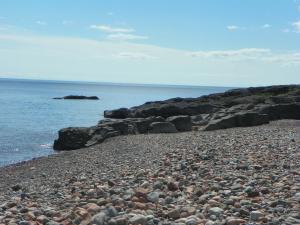
The Barren Shore
I've traveled far and wide to find
Sweet love so deep, not found before.
And yet, did find most precious kind,
That makes this broken heart adore
Love's passion found on barren shore.
Felt like a fleeting memory of
A fire one could not ignore.
This passion's set to rise above
All hurts and pains ever endured, now buoyed by Love.
| Author Notes |
Love's touch overcomes a broken soul.
This is a Spenserian Stanza. It has 9 lines total. The first 8 are in Iambic tetrameter. The 9th line is an Alexandrine written in Iambic hexameter. The rhyme scheme is as follows: (a-b-a-b-b-c-b-c-c). |
![]()
By Treischel
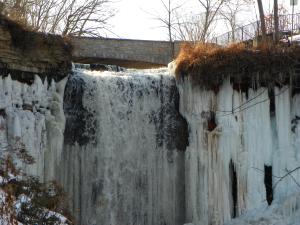
Fantastic Frozen Falls
Once temperatures drop to when water will freeze,
While ice forms upon our lakes,
It's great when it reaches the proper degrees
To find out what nature makes.
There's a special spark when the air gets a chill.
Hiding in a special place,
An amazing sight that will give you a thrill,
Enough to make your heart race.
In Minneapolis, at the edge of town,
There is Minnehaha Falls.
Sparkling crystals dance as cold water drops down
Creating tall frozen walls.
The Ice on the left forms a ghostly choir,
An ice organ on the right.
The sound echoes deep within a glass spire,
Resounding around the site.
It's a marvelous sight, as sun starts to drop.
Center falls in cold cascade.
Music plays, as water goes over the top
In wintery serenade
Yes! Sights and sounds are so rare,
When Ice Crystals dance in air!
| Author Notes |
Minnehaha Falls is as intriguing in winter, as it is any time of year.
This is my first attempt of a Canzone Style poem, which was inspired by the poem Deep Purple Moon by Gungalo. Canzone: An Italian lyric poem of varying stanza length, usually written in a mixture of hendecasyllables(11) and heptasyllables(7), with concluding short stanza or envoi. I took this photograph of Minnehaha Falls from below in March 2012. |
![]()
By Treischel

Up North we go, to the legendary Land of Snow
Where Eagles soar high, and the Owls hoot after dark,
Where the Lakes are Blue, and the cold rivers flow,
Sits the famous Itaska. It's a Beautiful, Bountiful State Park.
Entered the Gate anxious to see the mighty river's source.
The East Entryway was miles away: Winding, Narrow, and Long.
Anxious to see the mighty Mississippi, encountered delay, Of Course!
Newlywed pair, Nose in the Air, is plodding slowly along.
Vacation, you know! Family in tow. Needing to make Time.
Labor Day crowd, Laughing and Loud, filled the Park today.
Groan, Gripe, Glower, 3 Mile Hour, is a thoughtless Crime.
A Twenty car row, Nowhere to go, Hours frittered away.
Horse drawn Carriage makes me Disparage its plodding pulling works.
The Oblivious Two, Terrible Traffic Queue, really are just Jerks.
| Author Notes |
While on Vacation this summer, on Labor Day we drove from our campground at Lake Bemidji, Minnesota to a side trip destination. Itaska state park was only an hour away, so we could just scoot over and be back in time for dinner. Once there,from the entry way to the spot to get to the Source of the Mississippi River is about a 15 mile stretch along a two lane winding road. Just inside the entrance, a wedding party was taking a leasurely carriage ride, holding traffic to 3 MPH, sometimes less. I was the second car in a queue that went back as far as my rearview mirror could see. Every once in a while the wedding couple would turn around and salute the cars with a bottle of beer. Im sure they had a wonderful time.
So I dedicacate this Sonnet to the Newlyweds My wife took this picture through the windshield |
![]()
By Treischel

Boundary Water's Canoe Area (BWCA)
Drawn to Northern Minnesota,
Where waters and skies blend to blue.
"Land of Lakes", named the Dakota,
A land that French Voyagers knew.
In birch boats, as they paddled through
Hunting beaver, riding the waves
Exploring trails with native braves,
Those pioneers that led the way,
In lifestyle that a brave heart craves,
Outdoors in the BWCA.
Now, hundreds are drawn to those lakes,
To Ely, the end of the road.
Pack your gear, whatever it takes.
Duluth packs can carry the load,
As food for a week can be stowed,
In canoes using ropes and ties,
Carried under beautiful skies,
Float and fish, you travel all day,
Camp, make fire, as fish dinner fries,
Outdoors in the BWCA
After dark on a starlit night,
With a campfire blazing away
Northern Lights give cosmic delight,
When the breathtaking Milky Way
Creates loss for the words to say.
There's the haunting cry of the Loon.
Then Timberwolf adds in his tune,
While Crickets and Cicadas play.
It seems that it ends way too soon,
Outdoors in the BWCA.
Don't forget lakes so crystal clear,
The fishing, and spotting of Deer,
When wilderness takes you away,
Can't wait to come back here next year
Outdoors to the BWCA.
| Author Notes |
This Poem derives from my love of the BWCA.
The Boundary Water's Canoe Area (BWCA) is named that because it is located on the boundary between Canada and the United States. It is a vast area of many lakes that are connected by pathways known as Portages, where you carry your canoe and backpacks over them to the next destination. The French Voyagers used these trails to carry them all over the North Central United States and Canada in the 16 and 1700's. As a young man I went up there often on one week or two week vacations. Some times portaged 20 to 30 lakes in a trip. You needed a good waterproof map, a compass, food and gear, and a strong back. Usually, at the start a pack would weigh about 100 pounds. Usually there was just two of us. One would carry a backpack, the canoe with paddles and fishing gear stuffed inside. The other would carry one pack in front, the other on the back, and anything else loose. Portages were marked in rods, and would be anything from 10 to 200 rods long. Ely is a town in the central part of northern Minnesota that is one of two main entry points into the BWCA. The other is along the eastern North Shore Area of Lake Superior out of Grand Marais, along the Gunflint Trail. I prefer the Ely area, but have done both. Duluth pack is a heavy duty back pack made by the famous Duluth Company of Duluth, Minnesota. It is made of heavy canvas with strong leather straps. Usually bought by size, The are Number 2, 3, 4, and 5 sizes that get larger as the number increases. For portaging #3, and #4 are the best. They last forever, and are fairly waterproof. DOUBLE REFRAIN BALLADE SUPREME: A Ballade Supreme with an extra refrain. All lines must be the same metrical length (isosyllabic/same syllable count). This one uses an 8-syllable count per line. It is American in origin. There are 35 lines in this form, 10 lines to a verse, plus the extra refrain of 5 lines .Rhyme Scheme: ababbCcdcD, ababbCcdcD, ababbCcdcD, cCdcD. This poem was inspired because of it's format, which I discovered when I reviewed Gungalo's poem My Being remains Afire. Her poem was a Romance. I chose Nature for mine. The photograph of the campfire is one of my own. |
![]()
By Treischel

Pig's Eye Perrant
Now hear this story of Pig's Eye Perrant,
And a town named with a very diff'rent slant.
Oh, we'd rather forget it, but we can't!
Have you visited a town called Pig's Eye?
It's now known as the city of St. Paul.
Once, a danger to any passers bye
Where a river pirate with strange eyeball
Would terrorize the trav'lers, one and all.
He brewed up bitter batches of his hooch
Sold to Indians and the military.
He offended ladies he'd try to smooch,
'Cause his white-circled eyeball was quite scary,
He never found a woman he could marry.
The Tavern by his cave was just a shack.
Some said that his manners were rather rude.
Several customers never came back
Because his wilderness habits were crude,
And they didn't like the things he pursued.
This bloodthirsty fiend was an evil knave.
He'd come out to pillage river traffic.
Then hide the stolen loot in river cave.
To get just a little more specific,
His impact on settlers was horrific.
A town grew up nearby, named Pig's Eye Landing,
His danger, piggish manners they abhor.
Citizens deplored town's tawdry standing,
Disenchanted by this famous rogue neighbor,
Were moved to lose this threat and his bad liquor.
They gathered up the courage to report.
A delegation trip was quickly planned.
Approaching Colonel Snelling at the fort,
To eliminate Pig's Eye from their land,
They begged the Army leader, "Take a stand!"
A troop of soldiers was quickly dispatched,
In early morning, while the day was young.
From his dark lair, Pig's Eye was quickly snatched,
The soldier's trap had suddenly been sprung.
And since that day, Pig's Eye's song has been sung.
That town was then renamed, after their church.
Its citizens no longer lived in fear.
His name still echoes softly, if you search,
On city dump and bars stools around here,
And after him, they named a Pilsner beer.
So, that's the story of Pig's Eye Perrant,
And town named with a very diff'rent slant.
Oh, we'd rather forget it, but we can't!
| Author Notes |
An Early Settler of Bad Renown. Glad they changed the Name of the Town. Who'd want the Capitol City to be Named Pig's Eye.
According to A History of the City of Saint Paul by John Fletcher Williams (published in 1847), one of the first settlements in the St. Paul, MN area was located at Fountain Cave, alongside the Mississippi River (not far from where current day Shepard Road and Randolph Ave intersect). Pierre Pig's Eye Parrant, a retired fur trader and person of dubious reputation, built the area's first structure known as the whiskey seller's cabin at the mouth of this cave in 1838. The cave had a very clear, cold stream flowing out of it and into the river. Parrant was a coarse, ill-looking, low-browed fellow with one good eye. His bad eye had a sinister white ring around the pupil, giving it a kind of piggish expression to his features and he became known as Pig's Eye. Pig's Eye snuck over territory lines and found this rather convenient spot from which he could raid river travelers and sell bootleg whisky to soldiers and Indians without the pale of law. In 1838, Parrant erected a cabin at the mouth of the cave to sell liquor from. Locals called the area Pig's Eye Landing based on Parrant's popular tavern. His Pig's Eye Tavern flourished, but in 1840 he was evicted by soldiers from nearby Fort Snelling. Eventually Schmidt Brewery made beer at that site. That spring water in the cave has been the foundation for many beers. Today, Landmark Beer owns it. There's a tap outside the Brewery where any citizen can come and fill up jugs of water for free. I did this in a mixed meter. The Picture is author's photograph. |
![]()
By Treischel

At Last
(5-7-5 Poem)
weather finally warmed
went out to the driving range
lots of rusty swings
| Author Notes | Four days ago we had 5 inches of snow. The last two days was in the 70's. Hit the driving range. Had the top down. Hurray! |
![]()
By Treischel

The LEGO Court
(Short form Sandwich)
Kids cavort
At the LEGO court
Parents watch
With inventive play
Tiny blocks give happy tots
Creativity
Young minds churn
As they look and learn
Elders rest
| Author Notes |
This is the little courtyard at LEGO Land where the kids can play using LEGO pieces in those center well tables while the parents watch and rest.
This poem is a short form sandwich. It has a 5-7-5 format sandwiched between two 3-5-3 formats. OK, there is no such thing. I made the form up. But that is the structure of this particular poem. This photograph was taken by the author at Mall of America in July 2012. |
![]()
By Treischel

Amusement Park
(A 12 Line Exhortation)
WELCOME!
Nickelodeon Universe
Can make any troubles disperse.
Just open up your dusty purse.
There's no boredom
When families come.
So many things to catch the eye,
That roll and spin or make folks fly.
Give a carnival game a try.
Our world traverse.
In play submerse.
WELCOME!
| Author Notes |
When you go to the Mall of America, you can't pass up the amusement park there right in the middle of all the shopping and eating.
Another poem in my Mall of America series. This poem is a 12 Line Exhortation. I researched poetry types with 12 Lines to see what they are called. I found a group of poems called 12 Lines. But they are basically unstructured. I wanted some specific structure. I wanted a poem with 3 consecutive lines of rhyme, that played off 8/4/2 syllable counts and was positive in spirit. So I created this format and called it 12 Line Exhortation. I don't think this format previously exists, as far as I know. Let me know if otherwise. Here are the rules. A 12 Line Exhortation is a poem with 12 lines, starting and ending with a 2 syllable line that caries an exhortation, like; Get up!, Move on! Go jump! The whole syllable structure is; 2/8/8/8/4/4/8/8/8/4/4/2. There is also a fixed rhyme scheme of: AbbbaacccddA, where the capital letters shown here are the repeated lines of the Exhortation. This photograph was taken by the author himself at the Mall of America in July, 2012. |
![]()
By Treischel

Bull
(A Cinquain Poem)
Brown Bull,
LEGO Warrior,
perfect plastic eyeful.
How well this bovine head adorns
sharp horns.
| Author Notes |
This is a warrior bull completely made out of LEGOS at LEGO Land in Mall of America
This poem is part of my Mall of America series. A Cinquain is a fixed format poem of five lines that has a structure based on syllable count. The count changes from line to line as 2-4-6-8-2. The style does not require rhyme, but I chose to use rhyme on this poem. The rhyme scheme is abacc. The photograph was taken by the author in July 2012. |
![]()
By Treischel

Peeps and Company
(Sonnet Format)
If they are craving candy,
Families love to visit PEEPS.
Sweet choices are all dandy,
Tempting all to purchase heaps.
Mike and Ike are so chewy,
Hot Tamales make you roar,
And others that are gooey,
In this favorite candy store.
Bring the kiddies in to see
What sweet goodies they might like.
Choices pondered happily
Smile the faces of each tyke.
While friendly staff always keeps
It pleasant at pop'lar PEEPS.
| Author Notes |
There is a PEEPS candy store at the Mall of America, that is popular with anyone who has a sweet tooth. PEEPS are iconic at Easter time, but good any time of year, with their marshmallow center and colored sugar coat. Plenty of other choices too.
This is part of my Mall of America series. This poem is structured like a Sonnet, but doesn't meet all its criteria. The 7 syllable count is generally not used in Sonnets, and the verse is clearly not iambic, but it does have the three quatrains with abab rhyme scheme followed by a closing rhyming couplet, which is typical of a Sonnet. The picture was taken by the author at Mall of America in July, 2012. |
![]()
By Treischel

Ride High
(5-7-5 Poetry)
when you feel so low
a Nickelodeon ride
will take you up high
| Author Notes |
A Group goes up to the top on a Mall of America ride in the Nickelodeon Universe amusement park.
Another poem in my Mall of America Series This photograph taken by the author. |
![]()
By Treischel

LEGO Land
(Quatrains with closing couplet)
When you visit Lego Land
Let your imagination fly.
Amazing sights linger there
On walls and in the building's sky.
Tigers, bulls, and robots stand,
As tiny pieces interlock.
You won't believe what can be made
From little colored plastic blocks.
There's a court with blocks on tables,
Where you can let your children play,
To work on their little projects
As their parents shop away.
See tall wall of colored pieces,
Friendly sales reps helping you
To fill up several shopping bags,
As you spend a buck or two.
A wonderland you might call it,
But hold on to your wallet.
| Author Notes |
Another poem in my Mall of America Series. LEGO Land is an amazing place to see. They have built statues out of LEGOs that are 8 feet tall. Tigers, Warrior bulls, Robots, Helicopters, Snakes, Dragons. They are incredible to see. There is a shop, and a children's court with lots of LEGOs for the kids to play with while you shop. There is a tall wall with bubbles containing all colors of the plastic blocks that you can partly see in the lower middle portion of the photograph.
My last lines are not referring to thieves or pickpockets. That's not an issue there. I only refer to the temptation to spend. This poem is written in four quatrains with an abcb rhyme scheme. The tempo is set with variable interplay of 8/7 syllable count. There is a closing rhymed couplet. This photograph was taken by the author at Mall of America in July, 2012. |
![]()
By Treischel

Mall of America
(ABAB Quatrain with refrain and Envoi)
Just an Amusement Park inside
Mall of America
A shopping mall of several floors
An outdoor replica
Inside
Whether it's hot or cold outside
The climate says Welcome
To shop or take a thrilling ride
Grab a meal when you come
Inside
When winter's cold gives you the blues
There's a place you can go
When summer's heat creates issues
Airconditioned airflows
Inside
In here you can shop 'til you drop
A family friendly place
Enjoy the food and clothing shops
Even free parking space
Inside
So come and play
Shop all day
Inside
| Author Notes |
My grandson just had a 9th birthday and his parents took him to Mall of America. It a huge shopping mall that is a major tourist attraction here in Minnesota. Aside from being a refuge from the weather, is has 4 large floors of shopping and restaurants. The 4 parking ramps around it are free. Minnesota does not tax clothing. There is a huge amusement park and an aquarium in the middle of it. It is located just 10 minutes away from the Minneapolis/St. Paul International Airport (MSP) and about 25 minutes away from my house.
So, I thought I'd do a poetic series about it. I hope you like it. Here's the first. This poem is structured as a set of abab rhymed quatrains with a one word repeating refrain - Inside. It also has a closing envoi. The syllable count is /8/6/8/6 on the stanzas, and 4/3/2 on the Envoi. Lack of punctuation is intentional. The author took this photograph himself in July 2012 at Mall of America. |
![]()
By Treischel

Climb and Slide
(Quintet)
Climb to the top,
Swirl down the drop.
When you try this slide
It's quite a ride!
W
| Author Notes |
This is one of the rides at Mall of America. To be able to slide down 4 stories you have to climb, tethered to a safety rope, up an obstacle course. It's a real challenge.
This quintet is a 5 line poem with a rhyme scheme of aaabb. Its syllable count is 4/4/3/5/4. The photograph was taken by the author himself. |
![]()
By Treischel

A Simple Walk at Lake McCarron
(Quintets and Quatrains)
I walked the path around the lake
With choice of directions to take.
I chose the way that's most serene,
To see the sights that might be seen,
Where willows blend with evergreen.
I watched the clouds that drifted by
In quiet sky of azure blue.
A pleasant scene soon caught my eye,
Beyond the growth I'm peeking through.
See large homes on opposing shore,
A sight a painter might adore.
I stopped to look and take a break,
To get relief from slight back ache,
Sight camera for shots I'd take.
I thank the Lord for this fine day -
The water, sky, the trees and birds -
That bless the soul in every way
Beyond the scope of simple words
| Author Notes |
With all the lakes and rivers in Minnesota, each neighborhood has it local lake. There is usually a path around it and a public beach on most city lakes. I like to find them and walk around them. This poem and picture is of Lake McCarron located off Rice Street in a Northwest part of St Paul. It has 72 Acres of water.
This poem is simply Quintets (5 Lined Stanza) and Quatrains ( 4 Line Stanza). The syllable count used on both is 8. The rhyme scheme on the Quintets is: aabbb. The rhyme scheme on the Quatrains is: cdcd This photograph of Lake McCarron was taken August 3, 2013. |
![]()
By Treischel
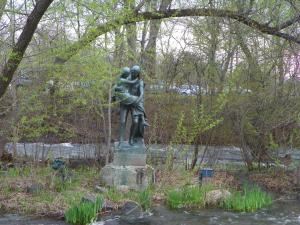
Lover's Leap
Hiawatha standing there
With Minnehaha maiden fair,
Had a love that was forbidden.
Found they couldn't keep it hidden.
History simply now recalls,
Their lover's leap, off the falls.
| Author Notes |
The legend of Minnehaha and Hiawatha is depicted in a statue at Minnehaha Falls in Minneapolis, Minnesota.
Photograph is the Author's |
![]()
By Treischel

Surfin' Superior
Grab your board, Superior's good!
It's the right time to ride the wood.
Get a wet-suit, the water's cold!
It's a wet sport, just for the bold!
Wouldn't pass this up, if I could.
Grab your board, Superior's good!
Wind's blowin', makin' gnarly waves,
Get on out there! Past the ice caves!
There's nothin' like this, anywhere!
Showin' our stuff, in freezin' air.
Grab your board, Superior's good!
Cold waves have crested, as I stood.
Gotta do it! 'Cause it's a rush!
Paddle out there in chilly slush.
Freezin' water is understood.
Grab your board, Superior's good!
| Author Notes |
You don't need Hawaii, California or the Atlantic coast to Surf. We surf right here in Minnesota any time of the year. Hardy Minnesotans were out surfing this weekend in March as I shot this picture. Bold and Cold! That's livin'.
Poem is 8 count syllables and aabb rhyme scheme. Took this picture 3/2/2013 with my Sony camera. |
![]()
By Treischel

Let's Show Mommy
Oh Daddy! Such pretty Flowers!
Let's show Mommy!
She's home, been waiting for hours.
Give me a lift.
Let's bring a gift.
Hurry Daddy! Bring those flowers!
Let's show Mommy!
| Author Notes |
A Dad with his helping hands full. A photograph begging for these words.
This poem has a syllable count of 8484484 and a rhyme scheme of aBaccaB. I took this photograph in August 2012 at the St. Paul farmer's market. There is an appartment building across the street from the Market. As I was walking into it, I spotted this scene taking place and couldn't resist taking the picture. My Muse finally kicked in, but I've been wanting to write this poem for a while. This will become part of my Picture Poem book. |
![]()
By Treischel

A Good Day - Fishing
Lovely water lily drinks morning sun,
On floating leaves and stems of darkened green.
A perfect place for frogs and dragonflies.
A trout or bass might lie beneath the scene.
So dip a paddle into waters cool,
Upon sun silvered surface silently
Drift and cast a line out, towards the reeds,
Until something big strikes it suddenly.
Now set that hook firmly in fishes mouth,
And feel the thrill of pull and jump about.
As fight for freedom so quickly ensues,
With skill and patience, soon you land a trout.
Now proudly display the catch of the day,
And then release it, watching it swim away
| Author Notes |
Lily pads, frogs , and fish, under a clear blue sky, on sun slivered water.
Ah! What bliss is this! From my photo collection |
![]()
By Treischel
Football Season's Here
(Sculptured Verse)
Football season's here.
Can't wait to shout and cheer!
The MN. Vikings will finally take to the field.
All their starters ready to have for their future revealed,
In a very tough division, where you find no team's fate is sealed.
I'm anxious to put on purple paint to watch my favorite players play.
I will be watching on television or at the game stadium on Football Sunday,
While I root for a rout of each opponent, or, if not, then at least for a close win.
I'll tell you, it is very hard to hold it all in. I'm anxious and ready for each game to begin.
After practices, scrimmages, and the pre-season blows, all surviving players are ready to go.
Fill up the stands. The place is jumping. Fan's heartbeats are thumping. Get on with this show!
><><><><><><><><><><><><><><
No matter the venue. Don't care if it's road game or home game, all the same, fans just want a win.
Toss that coin, select the field, play the National Anthem. Then line them up. Let the game begin.
Watch the starting kickoff as the ball sails aloft. Relish the mayhem; whistle, yell and scoff.
Just can't wait to see Adrian Peterson run with the ball, when that guy gets the call,
On Defense, when Jared Allen makes the opposing Quarterbacks take a big fall.
Ponder to Greg Jennings, Jerome Simpson, or Joe Webb, would be sweet.
Even some Blair Walsh field goals would get fans off their feet.
With Twenty Eight up the middle or Seven goes deep;
These are the memories that will certainly keep.
Hoping Chad Greenway snags one too!
Purple turns other team blue.
Go Vikes!
Show Purple Pride!
Shout, cheer, let out a Skol,
Take us fans to the Superbowl!
ARE YOU READY FOR SOME FOOTBALL!!!!
| Author Notes |
Cheering for my Minnesota Vikings at the start of the season.
This poem is intended to be shaped like a football, No specific meter, but the lines have been rhymed. |
![]()
By Treischel
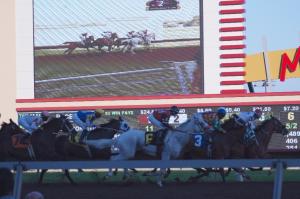
Canterbruy Downs
(Quatrains)
If horse racing is the sport of kings,
Then I'm sure feeling like royalty.
When I take the family to the track
Look forward to a good day for me.
The jockeys wearing colorful clothes.
The horses lined up in numbered rows.
Handicappers forecast horse's fate.
Fans throw down money at betting gate.
The bugle blows as they parade in.
Horses in their gates, ready to run.
Got money on one I think will win.
They're off, at the blast of starting gun!
As powerful hooves churn up the turf,
They flew down dirt like rolling thunder,
While cheering fans all screamed for their horse,
Transfixed by the spell that they're under.
When they came through their turns breathing smoke,
The jockeys were all going for broke,
By giving straining horses their head,
Driving hard down the home stretch they sped.
Dreaming about the winnings I'd fetch,
With the leading horse, I'm in heaven!
But then, it faded in the last stretch.
Too bad I bet on number seven!
| Author Notes |
went to Canterbury Downs, the horse racing track in Shakopee, Minnesota on Friday night, August 16, 2013. I actually did bet on number 7 in this race. The photograph was taken as they were coming into the finish line. Number 7 is the last horse in this shot. OK, I didn't win this one, but I did win the next four races, and came home with more money than I went there with. It was a Marvelous evening.
Went there with my daughter, Aisha, and my grandson Jeremy, as guests of the University of Minnesota, Alumni Association. This poem is written in mixed Quatrains. The syllable count throughout is a consistent 9 count. But the rhymes vary in each as either abcb, abab, or aabb, depending on the stanza. The photograph was taken by the author himself. |
![]()
By Treischel

St. Paul in the Fall
(Quatrains)
In the season of fall,
All the streets of St. Paul
Put on autumn colors,
Surpassing previous pallors.
.
As you drive around town,
The leaves tumble down,
Adorning city streets.
Providing quite visual treats.
Yes, St. Paul in the fall,
My most favorite time of all.
| Author Notes |
This is a street in the Cathedral area of St. Paul.
This poem has syllable counts of 6/6/6/8 6/6/6/8 6/8. The rhyme scheme is aabb ccdd ee. This photograph was taken by the author in October, 2012. |
![]()
By Treischel
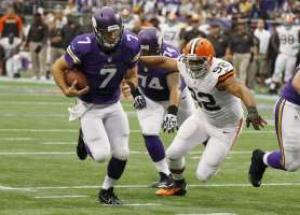
Purple Frustration
(Quatrains with refrain)
When season's high expectations
Are summarily dashed,
And yesterday's football standings
Are practically trashed.
'Cause the Vikings are letting me down.
You think back to dreams of the start,
As the changes were made,
When the future looked off the chart,
Planning our victory parade,
But the Vikings are letting me down.
Now, zero wins with three losses,
Is not what most fans thought.
From the frequent errant tosses,
Runners easily caught,
Means the Vikings are letting me down.
It is not the end of the world,
Disappointment galore,
But that's why the boos got hurled
When Ponder failed to score,
As the Vikings are letting me down.
Fans all hope to turn it around
To win a game or two.
So far it's a sad sound
The purple are making me blue.
Yup, the Vikings are letting me down.
| Author Notes |
In a bad mood today!
After a 10 win, 6 loss season and getting into the playoffs last season. The team made a number of changes to improve the team. So, expectations were high at the start of this season. Superbowl expectations. Christian Ponder is the Minnesota Vikings Quarterback. Purple and Gold is the team's colors. "Purple Pride" was the team's motto. The 1970's Defensive line was known as the Purple People Eaters. We often refer to the team as just The Purple. Picture from Yahoo Images |
![]()
By Treischel

Perplexing Ponder
(A 5A Poem)
purely perplexing
pondering Ponder's
putrid performance
| Author Notes |
Sorry, with a name like Ponder, what poet couldn't resist the temptation at alliteration?
Christian Ponder is the Quarterback of the Minnesota Vikings. I can't say he lost us the Game, but he threw away several chances to win it. This poem is a 5A poem A 5A poem has 3 lines of 5 syllable count each. Alliteration on every line, but it's not necessarily the same alliteration on each. I chose to make it mono-alliteration. This format was created by DRG24. Image is from Yahoo Images. |
![]()
By Treischel

Potted Plants
(Quintet)
Daylight shines on potted plants.
The silhouette makes colors dance,
On sidewalk with a bright display,
To liven up book searching day
In the front Library entrance.
| Author Notes |
This pot of lovely plants is outside on the sidewalk in front of the Woodbury, Minnesota library. The sun was shining brightly and I liked the look of the way it silhouetted the dark leaves, so I snapped a picture. Do I usually take my camera to the Library? No. It was in the car. I ran and got it.
The loveliness of the setting inspired my muse to write this poem. Just a simple Quintet (5 lines) with aabba rhyme scheme. This photograph was taken by the author himself on August 12,2013. |
![]()
By Treischel

On the River
(Rhyming Triplets)
Starting on stony river bank,
Our team of girls soon settle in
To boat, assigned in ordered rank,
To row, row, row.
The water was perfectly calm.
Each athlete ready to begin,
By putting ore into each palm,
And row, row, row.
We slipped into the stream so smooth,
Swift strokes powered by back and shin,
Raw river elements to soothe,
And row, row, row.
As down the runnel trace we race
In a feverish pace to win.
This river is a perfect place,
To row, row, row.
"Row, row, row your boat,
Gently down the stream.
Merrily, merrily, merrily, merrily,
Life is but a dream"
| Author Notes |
I spotted this rowing team along the Mississippi the other day. I took this camera shot. Of course, it inspired a poem. Here it is.
This poem is a set of Rhyming Triplets with a repeating refrain and closed with that famous nursery rhyme. The first and third line of each Triplet stanza rhyme. The second line rhymes with the second line of every Triplet stanza. It has a syllable count of 8. The rhyme scheme is: aba cbc dbd ebe. The picture was taken by the author himself on August 23, 2013. |
![]()
By Treischel

Pleasant Promenade
(A Cinquain Poem)
Charming
Fancy flowers
On pleasant promenade
Leads past grass scene with water sprayed
Bowers
| Author Notes |
The pathway to the Frog pond at Como Park. Not sure if you can see the sprinkler going in the background. The Roman arched Cupola is just around the corner.
Promenade - fancy name for a walkway Bower - shelter of boughs or vines, an arbor. This poem is a Cinquain. A cinquain is written using a pattern. "Cinq" [pronounced SINK] is French for the number 5. This type of poem only has five lines. Each line follows a specific pattern. There are many ways to write this type of poetry. The traditional Cinquain, as developed by Adelaide Crapsey, has five lines and a strict structure based on syllable count. Line 1: Two syllables Line 2: Four syllables Line 3: Six syllables Line 4: Eight syllables Line 5: Two syllables This photograph was taken by the author himself. |
![]()
By Treischel
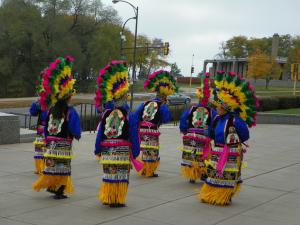
Colorful Rite
(A Lantern Poem)
Rite
honor
religious
plea in motion
Pray
Bob
shuffle
tapping feet
vivid display
Dance
Garb
faith show
the Virgin
saintly regard
Dress
Hat
feathers
bright colors
native headdress
Cap
Hue
color
appearance
gay exhibit
Tinge
Fringe
buckskin
tasseled skirt
swaying ribbons
Pomp
| Author Notes |
Mexican Indian dance in honor of Our Lady of Guadalupe. Religious rite in colorful garb performed in front of the Cathedral of St. Paul, Minnesota.
Bob is meant as in bob and weave. Gay is meant in the sense of colorful, bright. This poem is a Lantern suite, which is a series of Lantern poems, inspired by a poem I reviewed by fellow Fanstorian, Sunnilicious, called Pumpkin. Thought I'd try one. A Lantern poem is a Japanese short poem describing a syllable noun. The syllable count is: 1/2/3/4/1. It must be centered, then have one syllable chosen to serve as a topic. Have the noun in the 1st to 4th syllable described then have one that can be a reinterpretation or a synonym. The Lantern poem takes the form of a hanging lantern, going from short to wider as the poem goes on, and then becoming short again in the final line. The purpose of the Lantern poem is to illuminate the subject and re-imagine or personalize it for the reader, not just to simply define it. This photograph was taken by the author himself in October 2012. |
![]()
By Treischel

This Spot
(An Octogram Poem)
In stone fountain cool water drips
Making a splash.
Inspiring relationships,
As droplets crash.
With water and flowers full view,
And hues of Autumn there too,
The wonderful colors eclipse,
Making a splash.
Perfect place for idyllic trips
Found in a flash.
Lovely spot to kiss lover's lips
With pure panash.
This garden in downtown Duluth,
Is wonderful warren, in truth.
Into this well, wish of love flips
Making a splash.
| Author Notes |
A beautiful spot on a stone bench by a fountain in the Rose Garden at Leif Erickson Park, in Duluth, Minnesota. The dripping water, roses, and autumn leaves make it a special spot for lovers.
This poem is an Octogram. The Octogram is a style of poetry invented by Fanstorian Sally Yocom (S.Yocom). It consists of two stanzas of eight lines each, with a very specific syllable count and rhyme scheme. Syllable count is 84848884, repeat on second stanza. Rhyme scheme:ABabccbB ababddbB, where B repeats same text. No more than 16 lines. The tempo is tetrameter on the 8 count line, and dimeter on the 4 count line, but not iambic. This photograph was taken by the author himself. |
![]()
By Treischel

Duluth Hilltop
(Free Style)
Take me
to a hill above Duluth,
and let me watch
the color of the trees,
to feel the essence
of universal truth,
as I watch
autumn leaves
rustle
in the breeze.
I'll sit
and contemplate
the bountiful hills,
where I see the buildings
far off in the bay,
at the jaded junction
where emotion spills,
while
Superior blends horizons
further away.
This cathedral
of catharsis
sets my spirits free,
When
I look
upon its tranquil
dignity
that sets a current
of vitalizing
electricity
for me
by the lake that the Ojibwa named
"Gitchee Gumee."
To feel
the essence of universal truth,
Take me to
a hill above Duluth.
| Author Notes |
One of my favorite spots. It's too bad this photo shows so small. It's hard to see the person sitting at a table in the lower left of the photograph, the colors of the trees on the hillside on the upper left, or the details of the harbor in the upper right.
Duluth is a city of steep streets like San Francisco has. It sits as a harbor town at the Southwestern corner of Lake Superior. Gitchee Gumee is the name given to Lake Superior by the Native American tribe the Ojibwa. It meant "be a great sea". This photograph was taken by the author himself at the wayside rest just before you come into Duluth from the south. |
![]()
By Treischel

Farewell to the Dome
(AABBB Quatrains)
The Minnesota Viking's home
The Hubert Humphrey Metrodome
Has seen its final play
I watched it yesterday
It's had its better days
The last game played was won
But now the season's done
No play-offs in the wind
Team and fans chagrinned
A loss where hopes were pinned
But what a marvelous place
This multi-sporting space
That earned a special spot
In a downtown Metro plot
A dome that's seen a lot
It was brand spanking new
In nineteen eighty two
The toast of all our dreams
The host of many teams
Heard boos and howls and screams
Gopher baseball and football teams
With the Vikings and Twins, it seems
All set the sporting tone
But wasn't them alone
As other things were shown
Basketball, soccer, and monster jams
Rock concerts and motocross programs
All provided tenant fees
Tense moments with knocking knees
As exciting as you please
It prospered with several things it tried
With large capacity all inside
There were conventions and Expos too
And Special Olympics, to name a few
Among the many crowds it drew
It became a favorite indoor park
In a place where weather's always stark
With football, baseball, and basketball
It brought a boon to one and all
When nature's forces came to call
With two World Series wins
By the Minnesota Twins
In '87 and '91
Baseball legends were begun
That made the day for everyone
It also came very much alive
In fall, nineteen eighty five
With the MLB All-star game
As the best of season's fame
Saw the Padres -Tiger tame
Then Basketball's Final Four
Came through the City's door
In '92 and 2001
With lots of floor and hoop action
As the best of the colleges won
Again, its legend further grew
In nineteen ninety two
As that year's Super Bowl host
Saw the Washington Redskins roast
The Buffalo Bills, by scoring most
But before we get a bit too aloof
Remember its bulging and sagging roof
This impressive icon of our tinsel town
Changed our mood from cheers to frown
When winter snows brought ceiling down
It's time is now overdue
After all that it's been through
There are heartsick clientele
As we ring the final bell
I wish it - fond farewell!
| Author Notes |
It's the end of an ERA. The Minnesota Vikings played the last game of the season yesterday, 12/29/2013. So, I felt the need to pay a poetic tribute. They now are going to tear down the old stadium and build a new one. The dome originally was named the Hubert H Humphery, Metrodome after a State senator who was Vice-President of the United Stated for John Kennedy. He also unsuccessfully ran for President. The dome was known as The Humphrey Dome, the Homer Dome, The Hump, and the Metrodome. From 1982 to 2013, the Metrodome was the home to the National Football League's (NFL) Minnesota Vikings, Major League Baseball's (MLB) Minnesota Twins from 1982 to 2009, the National Basketball Association's (NBA) Minnesota Timberwolves in their 1989-1990 inaugural season, and the Golden Gophers football and baseball teams. It was also the home for the Minnesota Strikers of the North American Soccer League (NSL) in 1984.The Metrodome is the only venue to host a MLB All-Star Game (1985), a Super Bowl (1992), an NCAA Final Four (1992 & 2001), and a World Series (1987 & 1991). It has been recognized as one of the loudest domed venues in which to view a game.
In the 1992 Super Bowl, the Washington Redskins defeated Buffalo Bills, 37 to 28. In the 1985 MLB All-Star game, the San Diego Padres defeated the Detroit Tigers, 6-1. Five times in the stadium's history, heavy snows or other weather conditions have significantly damaged the roof and in four instances caused it to deflate. Gophers - are the teams that play for the University of Minnesota. Minnesota Vikings - the NFL Professional Football Team Minnesota Twins - the MLB Professional Baseball Team Minnesota Timberwolves - NBA Professional Basketball Team This poem is a series of quatrains with a rhyme scheme of aabbb. The meter is of variable length. Punctuation omitted intentionally. This picture is from. Yahoo Images. |
![]()
By Treischel

Como Frog Pond
(A Kyrielle Poem)
When lovers want to be alone
Among trees and water and stone,
The perfect place where hearts respond,
Right here at the Como Frog Pond.
It creates an idyllic scene,
While intrigued by small brown and green
Friends on the lily pads beyond,
Right here at the Como Frog Pond.
There's a feeling there that's solemn,
Standing by a Roman column.
They come in hope romance is spawned,
Right here at the Como Frog Pond.
Young couples may spend a day there,
Allowing new friendships to flare.
No better place for growing fond
Right here at the Como Frog Pond.
Some people plan their wedding day
In nature's church, their vows they say,
To join as one in loving bond
Right here at the Como Frog Pond.
| Author Notes |
Como Park in St. Paul, Minnesota has many beautiful spots where weddings are held. This is just one of them. The Roman Copula stands above a lovely pastoral tableau that includes the pond and vistas of the park. Not shown in this picture is a huge frog statue in the center of the pond.
This poem is a Kyrielle. A Kyrielle is made of quatrains that rhyme. Each stanza (that is a quatrain) has a line that repeats a line from a previous stanza. That line usually is (but does not necessarily have to be) the last line in the stanza. Each line in the poem has eight syllables. There is no limit to the number of stanzas. Usually there are three or more stanzas. Any type of rhyme scheme can be used. For this poem I chose to use an aabb rhyme scheme. This picture was taken by the author himself. |
![]()
By Treischel

Como Park Conservatory
(A Whitney)
Lovely park!
Beauty inside,
beauty out,
in the daytime,
after dark.
Just look about.
Como Conservatory!
| Author Notes |
A view of the outside of the Conservatory located on the grounds of Como Park in St. Paul, Minnesota. The grounds are open until sunset, the Zoo and conservatory closes at 5 PM. A lovely place in the summer. It is open year round and it is lovely to visit the plants inside during the winter.
This poem is a Whitney. The Whitney poem format was created by Betty Ann Whitney. This is a seven-line versed poem based on Japanese patterns with a fixed syllable format that contains 3, 4, 3, 4, 3, 4, 7 syllables respectively. No rhyme scheme is required, but may be incorporated if desired. This picture was taken by the author in September of 2013. |
![]()
By Treischel

The Falls
(A Sonnet)
As people gather at the park,
Where water falling leaves its mark,
Its sight definitely enthralls,
At Minnehaha waterfalls.
It pours profusely off the cliff,
Cascading in a rippling riff,
That fills the valley with its sound.
Its fame is known for miles around.
In spring, snow melting makes it grow
'Til narrow banks might overflow.
Crowds love to watch it from the bridge,
Observing it below the ridge.
So in conclusion, may I say,
I'd love to go there every day.
| Author Notes |
Minnehaha Falls is located in a wonderful park 5 minutes from the Minneapolis International Airport. The creek and falls are the major attraction, but there are miles of wooded paths, and lovely picnic areas. Bicycles and pedal-powered surreys are available for rent. Outdoor concerts are frequently given there during the summer. It also has a little known, but fabulous seafood restaurant. Pictured here is falls itself, taken from the steps leading down into the valley where the falls cascades. Weddings are often held on the bridge. This was taken in the spring before the leaves were out.
A riff - a riff is a musical term typically used in Jazz describes an instrumental phrase that embellishes the overall melody. This poem is a Sonnet, distinguished by its three quatrains and closing couplet. It is in iambic tetrameter with an aabb rhyme scheme. The photograph was taken by the author himself. |
![]()
By Treischel

Â
Iron River
Water flows
o'er iron ore
mineral red.
Rocky shore
so cold and bold.
It goes
past ancient stones
solid
slick
to fall
and
fold.
What bends to take
down
down to the lake.
It takes a hold
of my soul.
| Author Notes |
The red color of these rocks on the Knife River along the North Shore of Lake Superior in Minnesota is caused by the presence of iron ore. This area is famous for that ore and is a major part of the mining industry in Minnesota. This part of the state is known as the Iron Range.
The poem is written in free style. Free style is a sub-category of free verse. it carries the typical unstructured form, but contains rhyme. This photograph was taken by the author himself, just below the Highway 61 bridge over the Knife River. |
![]()
By Treischel

The sunlight on the water shines,
Creating bright wave top designs,
That flash and dance before my eyes,
To decorate the morning skies.
It sets this scenic water show,
As lake-borne traffic come and go,
That launches as the sun comes up.
Sunshine along with coffee cup.
I sit on shore and watch it all,
With splashing waves and seagull calls.
A breakfast in the lakeside breeze,
With view as pretty as you please.
Delight imbues this silver scene
With memories so seldom seen.
| Author Notes |
A bright morning on Lake Superior. The fishing boat heads out as I sip my morning coffee and watch from a hillside in March of 2012.
This poem is a Sonnet written in iambic tetrameter with an aabb rhyme scheme. This picture was taken by the author himself. |
![]()
By Treischel

The picnic's postponed.
The weddings are off.
The river is flowing
Right out of its trough.
Life near the river
Is often upset,
When Mother Nature
Makes everything wet.
The Mississippi
Has moods of its own.
Play close attention,
Or
Your plans could be blown.
| Author Notes |
This is Harriet Island in St. Paul, Minnesota. Shown is the picnic area and parking lot. The pavillion is used for weddings, especially in June. But the whole area is flooded this year, so picnics, weddings, and an event known as Taste of Minnesota were either cancelled or relocated due to the flooding. By the time I wrote this, the water was up to the windows of the building.
This picture was taken by the author himself. |
![]()
By Treischel

The Minnesota Fair
Had lots of people there,
Who filled the street from side to side.
Colossal human tide!
There's lots of things to do,
If you can push on through.
But lines too long prevented me
Proceeding merrily.
With very little shade,
There was a mass parade.
My grandson only saw their backs,
Or peeks between the cracks.
Still was a special day.
We found some games to play.
Enjoyed the food and rides at last.
It went by way too fast.
| Author Notes |
The day my grandson and I went to the fair had the highest attendance on record.
This is a short poem. A short meter Poem has a structured syllable count of: 6-6-8-6 done in an iambic flow of one or more quatrains. I shot this photo up near the west entrance to the fair. |
![]()
By Treischel

A bridge that spans across the chasm's void
Above the stream supporting lanes of life
Exists when steel and concrete are employed
By builder's knowledge honed sharp as a knife
I see the cars suspended in the air
Above a river wider than the sky
Two graceful arches make a stunning pair
Reflected off the water to my eye
The trees that line the banks are showing fire
Of Autumn's tinted tones that paint the view
Creating a tableau poets admire
As they're reflected off the water too
Then as I walked refreshed in Fall's brisk air
I stood transfixed along those river banks
Was blessed by scenery unfolding there
In breathless wonder, started giving thanks
| Author Notes |
This is a picture of the Lake Street Bridge, one of many that cross the Mississippi, viewed from a bluff at the end of Summit Avenue in St. Paul, Minnesota. The left bank is Minneapolis and the right bank is St. Paul. I was drawn by the reflections off the water, as well as the fall colors.
This poem consists of four simple abab rhymed quatrains in iambic pentameter. The photograph was taken by the author October 17, 2014. |
![]()
By Treischel

Pancake ice is forming
On beaches, in the shoals.
Waves begin transforming
Where swirling current rolls.
Slushy mix of liquid,
Prepared by Nature's touch.
Flapjacks that are frigid
Would make a lousy lunch.
Waves provide the syrup.
The table is the shore.
Fascinating set up
For winter gods of yore.
Not meant for the timid,
Or so the story goes.
Breakfast for intrepid
Legendary heroes.
Paul Bunyan resided
In northern woods domain.
Some think he decided
To eat this with champagne.
Very hearty breakfast
For hungry lumberjack.
A meal that's sure to last,
'Til hunger pangs come back.
This was oft' repeated
Within the lake's cool breeze.
Paul gets overheated
When chopping down the trees.
This cool and crunchy meal
Is not for everyone,
But it helps to congeal
The sweat of Paul Bunyan.
| Author Notes |
The ice shown here is known as pancake ice, because it looks like pancakes. I haven't seen it other places, but it is likely in Anticartica, Alaska and Canada. They may have it. Pancake ice is formed by strong wave and current action in freezing waters.
Paul Bunyan is a mythical giant lumberjack who, along with a giant Blue Ox named Babe, is credited with many tall tale adventures. There are many stories and even books about their antics. His footprints are said to have formed Minnesota's 10,000 lakes. Dragging his enormous axe dug out the Mississippi. He could cut down 100 trees with one swing of his Axe. His sweat filled up the Great Lakes. Many more tales are told. If you are interested in more. Google him. His stories are known as tall tales (get it?). Here is one of mine. This poem was written in Trimeter (6 syllables) quatrains with abab rhyming. This picture was taken by the author himself in March, 2013, just outside of Duluth, Minnesota. |
![]()
By Treischel

men out ice fishing
the Lake Superior style
only catching cold
| Author Notes |
Seem that's the most common catch some days.
The author took this picture on the shores of Lake Superior in March, 2013. |
![]()
By Treischel

Take me down to water's edge,
way down,
to smell the spume,
see the mist,
watch it
flowing past
so fast.
Oh mighty falls of Minnehaha,
bless us with your
roaring thunder,
splashing sounds
on
sacred stones
to sing your
ancient song.
We will gather in your mystic majesty,
to gaze
amazed
at
violent torrents
that
ripple wildly,
while
wanton waves
keep
flowing past.
Your cascade carved this deep depression,
chasm,
cauldron,
canal,
through the forest,
through mud and rock,
to force
clear water
down its channel,
long before
we came along.
Your cascade claims the Mississippi
as it
rapidly rushes
to join
in marriage,
its mighty mate
and
finally meet.
We sing your praises, oh wild water
while
gawking,
gazing,
in groups
that gather at
your feet.
We pray, may your waters
flow
forever.
Forever,
FOREVER.
| Author Notes |
Minnehaha Falls cascades into a chasm that it formed eons ago. It is located in Minneapolis, just 5 minutes from the Minneapolis/St. Paul Internatrional Airport (MSP). The creek flows into the Mississippi River about a half mile down stream from here. Tourists can reach this spot below the falls from three directions. Weddings are frequently performed on the bridges above or below it.
This poem was written in a Free Style format. A Free Style Poem is a subset of Free Verse. It has no rhyme scheme, tempo, or meter pattern. It just flows with the words. The author adds dimension in how the poem is felt, through the use of pace and pause, created in how the words are arranged on the page. The distinction between Free Style and Free Verse is that Free Style contains some rhyme while Free Verse does not. It rhymes in places as the author wants, but not necessarily consistently. In this poem, I tried to make each stanza a little replica of a waterfall. This photograph was taken by the author on May 6, 2011. |
![]()
By Treischel

Gnarled roots that anchor ancient trees
Guard the river banks.
Spreading reach with tendrils such as these,
Firm among their ranks.
Creating shapes so unique, askew,
While adding character to the view
That frames the sights while looking through.
Sentinels along the beach's flanks
Guard the river banks.
Undergrowth that tangle in the breeze
Guard the river banks.
Sights suggest there are no guarantees.
Pray for giving thanks.
There may be floods or excessive drought.
Simple clues are lying all about.
You'll see them through limbs, while looking out.
Tree roots that hold soil along its shanks
Guard the river banks.
| Author Notes |
The roots I'm peering through are located along the Mississippi River at the Ford Lock and Dam. So what's all this about prayers and no guarantees? In this shot, the drought has been so severe that a torent that usually would be pouring over the dam to the left of that building is merely a trickle. Also, the Ford sign, which is in front in the St. Paul Ford Production Assembly Plant that built Ford pickup trucks for years and had its electricity supplied by the dam, is now gone. The factory was closed and torn down.
This poem is a Nonogram. It is a format that I created. The "Non" indicates the usage of 9. It is a Poem with 2 stanzas of 9 lines. A Nonogram is similar to an Octogram, with similar rhyme scheme, except instead of integrating 8 and 4 meter, it uses 9 and 5. So the two stanzas flow with a meter of: 9-5-9-5-9-9-9-9-5. The rhyme scheme is: aBabcccbB aBabdddbB, where the capital letters indicates a repeated line. This picture was taken by the author along the Minneapolis side of the Mississippi, where Minnehaha Creek empties into it just below the Ford Dam, on March 4, 2012. |
![]()
By Treischel

The Mississippi River basin, frozen in the ice,
It's showing signs of melting as the water starts to pool.
The Ides of March are turning now, but it's still very cool,
The Mississippi River basin, frozen in the ice.
It's showing signs of melting as the water starts to pool.
The town around is bounded in a frozen winter scene.
The buildings and the bridges, that are looking so serene,
Present idyllic images resembling Christmas yule.
The town around is bounded in a frozen winter scene.
At dusk, to be highlighted by a pastel painted sky
Where pink and purple color hues are dominated by.
Frost fixes climate as the filtered air is brisk and clean.
At dusk, to be highlighted by a pastel painted sky
So cold, the stack belched smoke becomes suspended in the air.
Which paints a picture winter-made that's way beyond compare,
With lots of fancy lampposts that the roads are lighted by.
So cold, the stack belched smoke becomes suspended in the air.
This chilly channel sweeps around and travels through St. Paul,
Where, once the Ice is melted, riverboats begin to call,
To ship its cargo down to New Orleans and everywhere.
This chilly channel sweeps around and travels through St. Paul.
The Mississippi River basin, frozen in the ice,
Is, even in the winter, a hometown that's really nice,
With heated skyways linking buildings in the urban sprawl.
The Mississippi River basin, frozen in the ice,
It's showing signs of melting as the water starts to pool.
The season's hold is shifting where these frosty spirits rule
The Mississippi River basin, frozen in the ice.
| Author Notes |
A winter scene of the Mississippi River basin around St. Paul, Minnesota. Downtown St. Paul is not in this particular frame. It is out of sight to the right of the picture. The highbridge is shown in the background linking the bluffs of St. Paul proper with West St. Paul. The smoke is coming from the power plant. St. Paul has sandstone bluffs all around it. I'm standing on one, Dayton's Bluff, where I shot this picture.
This poem is a Catena Rondo. Catena Rondo is a stanzaic form created by 20th century Canadian educator, author and poet, Robin Skelton that uses interlinked repeating lines. The form lends itself to a longer poem because of the repetition of lines. Written in any number of 3 or more quatrains made up of 2 rhymed lines enveloping a rhymed couplet (enveloping rhyme). The second line of each stanza then becomes a link to the next stanza by becoming the first line of that stanza. Meter is at the discretion of the poet. The verses are rhymed. The rhyme scheme is: ABbA BCcb CDdc DEed etc ... until the enveloped couplet of the penultimate (second to last) quatrain repeats Line1 of the poem as line 2, thereby bringing the final quatrain back to the original scheme of the 1st quatrain ABbA. So,in this scenario, the only line of the last stanza that could be original is Line 3 since Line 1, Line 2 and Line 4 are repetitions of the same lines of the first stanza. This picture was taken by the author himself from Mounds Park on March 3, 2011. |
![]()
By Treischel

Each Friday night, and on Saturday,
The boys with their toys came out to play;
To ogle girls, and show off their cars;
To hustle some drinks at local bars.
As young men are conforming creatures,
"The Loop" became a weekend feature;
A figure eight for the grand parade,
A manhood rite to a serenade.
For ladies often were there about,
Along St. Paul's proven pavement route,
Where man and car can be admired
In hopes that romance be inspired.
The bigger the engine in the car,
Better the chances of getting far.
Detroit obliged by putting them out,
And plenty were seen along this route.
It's started by getting into town.
The Seventh Street Bridge will take you down.
It sweeps along past Mickey's Diner,
Where counter meals couldn't be finer.
To Seven Corners intersection
For Kellogg Boulevard connection,
A busy place where many may meet,
As concerts play and sports compete.
A hard right turn as the road goes on
Where Kellogg then meets with Marion;
Past Cathedral, then the government,
Where lots of women gain employment.
A left on to University,
A road of storied diversity,
So many stoplights along the way
Provide ample time for prime display.
This strip leads us to the treasure bin.
Our goal is to reach Porky's Drive-in,
Where a waitress in a skimpy skirt,
While taking orders, will prance and flirt.
All the coolest cars will wind-up there,
To consume Porky's hot, greasy fare.
Guys are bragging all about their fates,
In the hope their lies will get them dates.
When their puffed-up pride produces ire,
They'll start their cars and head down Prior,
Then turn right, on to Pierce-Butler Road,
To follow driving's most manly code.
It is here we have a well-known place
From which two fast cars can have a race;
A long straight-a-way on which to drag,
When a pretty lady drops the flag.
While friends on look-out watch for cop cars,
The contestants race to see who stars
In the challenge for a female's heart,
The chance to distinguish them apart.
Once the dust and choking smoke scatters,
It's just the winning car that matters.
As the fates have had their fickled say,
The rest can continue on their way.
Down the way and then a right on Rice,
The path to Kellogg is pretty nice,
Which takes one back through the heart of town.
You'll find the Post Office further down.
Jackson left turn returns to the start
At Seventh again, where you depart,
Or begin it over, once again,
Depending on what's happening then.
Success may pay a persistent troop
Down this pathway that's known as "The Loop".
| Author Notes |
This poem recalls a bit of my and St. Paul's history. When I was a 17 to 19 year old single guy, this was a typical weekend activity. My buddy owned a black 1959 Ford Gallaxy 500XL convertable that we used to cruise "The Loop", in search of females and other cars to drag with. Of course, we were too young to drink, but with fake ID's, it didn't stop us from trying. The Are between St. Paul and Minneapolis is known as "The Midway. Porky's is about halfway between both. This poem describes the route we took.
The poem is written in aabb rhymed quatrains. I chose an unusual 9 syllable count meter so that I could mix up the tempo and not be restricted by the iambs or other fixed conventions. The author created a montage with a rough map to illustrate the route in PowerPoint. |
![]()
By Treischel

If
you
do,
or
if
you
don't,
it
doesn't
matter
any
way.
I
Guess.
| Author Notes |
The Minnesota Twins, Major League Baseball Team has had 3 consecutive 90+ game losing seasons. The new season is just getting under way. Rah, rah.
This poem is a Word Sonnet. The Word Sonnet is a relatively new variation of the traditional form that was championed by Seymour Mayne, a Canadian poet who teaches at the University of Ottawa. This is Seymour Maynes's long-running project of what he calls and practices as "word sonnets." In their one-word structure there is a strong resemblance to the look and feel of Chinese poetry. These minimal forms of poetry and verbal composition go back to the 1960s. In essence, it is a fourteen line poem, with one word set for each line. Concise and usually visual in effect, this "miniature" version can contain one or more sentences, as the articulation requires. Word Sonnets attempt to be pithy and suggestive poems in their own right. Many draw on the seasons and also aim for a compact resonance that may attract the reader to return to them again and again. Just continuing to play with this format a bit. In this one I had a bit of fun in portraying the sports satire and the flexibility of expression. If you are interested in learning more about the style, here are two very informative links that you may want to paste into search line. The frist is an overview by Seytmour himself. The second is a hilarious, and very good, discertation on how to make it into a 14 Word Shakspearian Sonnet. http://poemsand poetics.com/2014/02/seymour-mayne-hail-15-word-sonnets.html http;//stephenfrug.blogspot.com/frank-sidwicks-fourteen-word-sonnet.html The author took this picture of his grandson, Jeremy at a Twins ball game in 2013 using his cell phone. Then posted it to his mom and dad. |
![]()
By Treischel

I.
Chicanery and greed played primal roles
With Minnesota forming as a state.
The story most intriguingly unrolls
With greed as they proceed to legislate.
The politicians ultimately prove
How perfidy provided utter gall,
Mischievous machinations plan to move
The capital away from far St. Paul.
This tale has mystery and true intrigue,
When dealing with corrupted governor,
Political patronage and fatigue;
A drunken gambler, prostitutes, and more.
So, grab a seat, get yourself a brew
Allow some time to let this tale unfold
About when boundaries were thrown askew,
With land in hand just begging to be sold.
As "Paul is robbed to pay St. Peter's" fee,
A page of Minnesota history.
II.
A page of Minnesota history,
When Franklin Pierce looked for a governor,
He picked a Mexican war man of glory.
Who captured Haumantla, hero of war.
A chosen leader for the future state.
A person of power, plans of his own,
To highest potentate, became his fate.
In eighteen fifty three, this true unknown
Was sworn in by the US President.
But this man had some problems in his soul
Of larceny, that some come to resent,
When greed would breed bad blood through his control.
For in the early days, on which we teeter,
Most representatives lived to the south.
Much easier to gather in St. Peter,
Than travel to St. Paul, much further north.
The situation rose among the clan
That laid the groundwork for a profit plan.
III.
That laid the groundwork for a profit plan,
Since Willis Gorman was the man in charge
Who thought his best investment was to pan
His holdings in St. Peter, which were large.
So, he convinced his crony legislators
To pass a bill to move the capital.
Began construction using huge road graders,
And building things around St. Peter's mall.
He laid out nicely functional foundations
With roads for heavy traffic, double-wide,
And found an architect for his creations-
A capital to fill the town with pride.
A perfect plan to denigrate St. Paul.
He hoped he'd be real rich once things aligned,
To his plots, in St. Peter, boons would fall.
The problem was the bill -- he hadn't signed.
The law requires Gov's to sign the bill,
But Willis stayed put in St. Peter still.
IV.
But Willis stayed put in St. Peter still,
To oversee the plans he put in place.
He needed trusty patron now to fill
The role of courier to quite quickly race,
A legate lacking scruples in the senate.
With proven loyalty, on whom to bet,
A lackey to be used as loose lieutenant,
And such a man was Joseph J. Rolette-
Furtrader, gambler, and a politician,
Controls enrollment bills within the house,
A natural to grab the proposition,
Though many men considered him a louse.
So, Gorman thought that Rolette was his man,
Entrusting Joe to find him right away.
While he himself laid out his full town plan,
Expecting harvest of a huge payday.
This bill of eighteen fifty seven passed.
Just need signing by the Gov'nor fast.
V.
Just need signing by the Gov'nor fast.
Here's what readers need to understand.
The legislative session wouldn't last,
Expiring the possession of the land.
Now, Joe Rolette should not have been so trusted.
Nobody had considered how he felt --
The capital's location readjusted,
Just wasn't how he thought things should be dealt.
This gambler's inclination was to hide.
He found a perfect hide-a-way hotel.
Ok, it had a brothel too, inside,
Where he could drink and gamble for a spell.
He'd hide there while the clock was ticking down,
While knowing, all he had to do was wait.
He dallied with the damsels until dawn,
And drank into a catatonic state.
But none of that was much of his concern,
With time that leads the senate to adjourn.
VI.
With time that leads the senate to adjourn,
While frantic politicians were distressed,
Police were called to find and overturn
The rocks, achieving poor Joe's quick arrest.
With all the constables in hot pursuit,
The ladies of the night had hid him well.
The hotel manager was in cahoots,
And all his gambling friends would never tell.
And so, our Joe stayed hidden for a week,
Enjoying all the pleasures one could want:
Rich hands of cards, hot ladies on each cheek,
And even fine chef's fare from restaurant.
Our fine French friend was hero of the city.
For his dynamic actions, tip a brew.
Had he not taken steps, would be a pity.
He taught the governor a thing or two
While dock of legislative session closed,
Joe entered meeting hall quite unopposed.
VII
Joe entered meeting hall quite unopposed,
And all there present knew it was too late.
With unsigned bill in hand, the cheering rose
From those opposed who know it met its fate.
The capital, St. Paul now would remain,
While anger from the governor and friends
Would fall forgotten, dusty lost refrains
Along St. Peter's newly formed dead ends.
While Willis Gorman to this very day
Will curse the name of Joseph J Rolette,
Whose gamble with the world came into play,
And caused a crooked plan to be upset.
'Til eighteen fifty seven Gorman ruled,
But never made the fortune he had sought.
It vanished like the wind, when he was fooled,
Thus proving loyalty cannot be bought.
Where power and high profits were the goals,
Chicanery and greed played primal roles.
| Author Notes |
This is a story about how the Minnesota State capital was almost stolen away from St. Paul and removed to St. Peter. A scenario just the opposite of "robbing Peter to pay Paul". It happened when the state was still a terrirory. Minnesota became a territory in 1849. The first Territorial Governor was Alexander Ramsey. He was succeeded by Willis A. Gorman in 1853 until 1857. Gorman, appointed by President Franklin Pierce, was chosen by Pierce because they served together in the Mexican-American war. He lead a rifle battalion in the Battle of Bueno Vista, where he was wounded. He served in the capture of the city of Huamantla, and many other battles. When he was appointed, he was an unknow political appointee. He moved to St. Peter, Minnesota and bought several large tracts of land. The town is located in the south central part of the state, on a well traveled road above Des Moines, Iowa. That state had been heavily settled by then. St. Paul, due to its location on the Mississippi, was designated the territorial capital, where the lawmakers of the day traveled to perform their legislations,and was much further north. But, unless you owned a boat, travel to St. Paul by land was long and dangerous due to bad roads and hostile indians. Gorman decided to use his power to make it easier on himself, and gain a tidy profit in return.
Joseph J Rolette was a French voyager and fur trader, who moved into the new territory in 1849, settling in the Red River Valley. He opened his own Trading Post in Pembina, a small town in far northwestern Minnesota near Fargo, North Dakota. He ran a line of Ox carts from there all the way down to Mendota, an area near Fort Snelling and St, Paul. It made him rich. There he met powerful men, like Alexander Ramsey and Henry Hastings. They helped him become a legislative representative of the Northwest. He served in the territorial congress as the Chairman of the Territorial Enrollment Committe. He served 4 terms. His boisterous background never left him. A treaty with the Indians was signed in 1851 Minnesota became a state in 1858. Costruction of the current capital began in 1896 and completed in 1905. It was built by Butler-Ryan, and designed by Cass Gilbert. Modeled after St. Peter's Bascillia in Rome (what irony), the unsupported marble dome, is the second largest in the world. Source: Wikipedia. To this day, St. Peter's wide streets and central mall are testamony to Gorman's plans. It is said that speculators purchased plots in St. Pater for $1,500, but later most sold for $15. Chicanery - tricks. Perfidy - treachery. Machinations -wily or evil schemes. Political Patronage - when votes are based on personal connections or payoffs, political favors. Crony - fellow conspiritors, close friends. Denigrate - embarass, bring low, belittle, defame. Boon - benefit. Courier - messanger, a person to bring things from one place to another. Lackey - menial servant, toady. This poem is a Crown of Heroic Sonnets. A Crown of Heroic Sonnets is a sequence of seven sonnets, usually addressed to some one person, and concerned with a single theme. However, instead of having the usual 12 lines with closing couples for a total of 14 lines, a Heroic Sonnet has either two octaves with closing couplets or 4 quatrains with closing couplets for a total of 18 lines. Each of the Sonnets explores one aspect of the theme, and is linked to the preceding and succeeding Sonnets by repeating the final line of the preceding Sonnet as the first line of the succeeding Sonnet. The first line of the first Sonnet is repeated as the final line of the last and final Sonnet, thereby bringing the sequence to a circular close. Written in iambic pentameter, no rhyme is to be repeated, except those of the repeated lines. The rhyme scheme is to be either: abababab--cdcdcdcd--ee (using octaves), or: abab--cdcd--efef--ghgh--ii (using quatrains). This photograph was taken by the author from the steps of the Cathedral in October, 2012. Some renovation was going on, so scaffolding can be seen. |
![]()
By Treischel

When streetcars rode the rails on city streets,
Before the buses took their favored place,
They were the transportation mode elites.
For decades they were the transit system's face.
But often, new technology defeats
Incumbents in evolving travel's race.
St. Paul was no exception to that plan.
So, let's discuss just how it all began.
Originally, there were horse-drawn fleets
That pulled along at slow and steady pace,
But cobblestones and mud made bumpy seats,
So miles of rails were laid, as was the case
For smoother ride, less pull on horse's cleats,
Who pulled the harnessed cars along a trace.
These vehicles were seen a something new
On avenues in eighteen seven two.
The seven horses needed -- made manure,
And pulling up the hills was way too slow,
While sickness with fatigue made times unsure.
There had to be a better way to go.
The owners, seeing ridership allure,
Invested later in a cable tow.
Installing cable drums, they laid the line.
Thus '87 saw a horse decline.
Pulled back and forth, the cablecars endure
The pressures that all iron cables throw.
While snags and breakdowns daily don't ensure
Anticipated goals of profit flow.
So pulling cables didn't seem the cure
As far as breaks and maintenance costs go.
But all that changed in eighteen ninety two
As Frank Sprague's new electric notions grew.
His streetcars, hooked upon a high-strung wire,
Sent constant current, motor to the wheels.
Then add appointments passengers desire.
The shiny brass and polished wood appeals
To tired riders going home, who admire
The view through glass, how wicker seating feels.
Thus was, before Ford's factory came along,
The need for transportation very strong.
In fact, they kept on stringin' wire higher.
Five hundred miles and more of mated steel
Made many Minnesota towns aspire
To have their own exciting streetcar deal.
And thus, it was just waiting to inspire
The ridership to much expanded zeal.
Two thirty million at its rider peak,
The transit system here was quite unique.
Two cities -- Minneapolis, St. Paul
Each had their own city transit plans.
'Till Thomas Lowery's family bought it all,
Consolidating ownership and lands,
Dug tunnels under hills they thought too tall,
An empire serving travel mode demands
From Stillwater and Bayport in the east
To Minnetonka -- west, it never ceased.
From Chaos would stability befall
While under Lowery's strong and able hands.
'til nineteen thirty one, a judgment call,
When he sold it to governmental fans
Who thought private businesses too small
To handle pent up needs as growth expands.
The fleet became eight hundred twenty eight
For nineteen forty's streetcar magistrate.
So, nineteen twenty cars drove riders down,
Until the Great Depression brought it back,
But cars and buses gained all over town,
And by the fifties rails were losing track.
Distinctive clanging bells of much renown
And its charismatic clickity-clack
Were on the verge of being heard no more,
And they were gone by nineteen fifty four.
The ghosts of streetcar days are still around.
The rails are there, but buried under black
Asphalt, like the cobblestones, to be found
When wear and tear has made the surface crack.
The Lowery tunnel's sealed and under ground,
And here and there you'll find memory plaques.
The riders went their way on wicker seats
When street cars rode the rails on city streets.
| Author Notes |
This is a story poem about Minnesota history. Specifically, it's about the reign of street cars there. The era lasted from 1872 until 1954, when a hostile take over of the Metropolitan Transit Authority caused buses to become the primary method of transportation. Buses were considered cheaper to operate, and the management felt that the existing assets could be sold for a profit.
Originally, the first ones of 1872 were long enclosed cars pulled by horses, called Horsecars, over mud roads and some cobblestone streets. The later use of steel rails made for a smoother ride and easier pull for the horses. It required a team of seven horses, who as one reporter noted, "Made epic volumes of manure". The rails continued to be used throughout the era. In 1887, a system of underground cables hooked to large drums holding long steel cables was used. A drum on one end would be activated to pull the car one way. Then a drum on the other end woud pull it back. At first powered by steam, then later by electricity, maintenance was a big problem. In 1887, Frank Sprague invented the use of overhead wires to send current to an electric motor. By 1892, St. Paul had adopted this method. Those lasted from 1892 until they were shut down in 1954, although the wooden and brass cars were rebuilt several times. This poem is a Otava Rima. It is a poem of Italian origin first introduced by Giovanni Boccaccio around 1350. The Ottava Rima stanza in English consists of eight iambic lines, usually iambic pentameters. Each stanza consists of three alternate rhymes and one double rhyme, following the: a-b-a-b-a-b-c-c pattern. There is no limit on the number of stanzas, and often was used in long epic poems. I got this picture from the Minnesota Historical Society, |
![]()
By Treischel

Beguiled by moored Mississippi riverboat,
I dreamt of cruising away
With paddlewheel painted a deep red coat.
And though many dreams may seem to be remote,
Felt the pull of yesterday,
Beguiled by moored Mississippi riverboat.
Dreams adrift, as Huckleberry schemes denote
Adventures these modes convey
With paddlewheel painted a deep red coat.
Then purchased ticket, secure within my coat,
Boarded along the gangway,
Beguiled by moored Mississippi riverboat.
Akin to Twain, I found these verses I wrote
Flowed so fluently that day
With paddlewheel painted a deep red coat.
That I shall henceforth devote
Time for reflective replay,
Beguiled by moored Mississippi riverboat
With paddlewheel painted a deep red coat.
| Author Notes |
St. Paul, Minnesota, is very much a river town. The Mississippi River is full of riverboats diven by paddlewheel. Some have the big red wheels in the back, these are called Sternwheelers. Others have two, one on each side of the boat. They are colorful, and put me in mind of the days that Mark Twain wrote about in his "Life on the Mississippi", "Huckleberry Finn", and "Tom Sawyer". I've taken short trips on several, but would love to ride the Delta Queen all the way down to New Orleans. This poem is about those riverboats and how they inspire me.
The poem is a Villanelle. The Villanelle is French form dating from the 15th or 16th centuries. The form's pattern uses a set of five three-line (tercet) stanzas rhyming: A1-b-A2, a-b-A1, a-b-A2, a-b-A1, a-b-A2, and a final quatrain rhyming: a-b-A1-A2. The first and third lines in the first stanza (shown as A1 & A2, respectively) are repeated verbatun to alternately form the final line of stanzas two to five and reappear as a couplet in the last Quatrain. So there is a lovely transition that neccessarily occurs through the repeats. This poem features only two rhymes (a and b), which adds to its difficulty to write. No set length of line is given, though 7 to 11 syllables were common in the original French. Iambic pentameters are often used in English versions. For this poem, I thought I'd experiment a bit with the original French forms by incorporating both the 11 and the 7 to create a long-short-long motif, which does not lend itself to iambic. So the syllable count becomes: 11-7-11 11-7-11 11-7-11 11-7-11 7-7-11-11 Hope you like how it turned out. This picture was taken by the Author himself in downtown St. Paul along the Mississippi on September 22, 2012. |
![]()
By Treischel

I.
A tragic case of misery and woe,
When cultures clashed and heated tempers flared
In places graced by lakes and buffalo,
When guns and blood was how the grievance aired.
Now consciously this tragedy unplanned,
Had viciousness of which you'd never think.
For eons past the natives loved this land,
Where bison by the millions came to drink.
Oasis cultures found a fall retreat
Where nature made an ancient hunting ground,
A place where pelicans and bison meet,
The shores were dotted with their funeral mounds.
A place to raise the children in their midst
Became home for Ojibwa and Dakota
Where peacefully the tribes could co-exist,
The corner of southwestern Minnesota.
This sacred land of hospitality
Was soon known for blood-hot hostility.
II.
Was soon known for blood-hot hostility,
When white men came and found this lovely place
About the year of eighteen fifty three.
At first the mood of hate was not the case.
For treaty land was purchased free and clear.
The Indians were promised aid and food.
So settlers could move in without a fear,
But greed and prejudice soon changed the mood.
As threats and promises flowed off the tongues
Of Ramsey, Henry Sibley, and Luke Lea
'Bout pots and pans, food, blankets and some guns.
The tribes assigned their place in the area.
But promises were hardly ever filled,
And tribal customs soon were dispossessed.
So, many starved and others hardships killed.
The chiefs and warrior braves were not impressed.
It mounted to a passion-heated brew,
The August days of eighteen sixty two.
III.
The August days of eighteen sixty two,
It started 'round the lake they named Shetek.
When Grizzly Bear's war party wandered through,
The Koch's cabin was a total wreck.
John Voigt escaped, the others were forewarned.
They gathered at Wrights cabin for defense.
Old Pawn with warriors were all badly scorned.
Surrounded now, the cabin mood intense.
Inside the settlers pondered what to do.
Old Pawn had always been a friendly sort,
But joined by Grizzly Bear's large hostile crew
The pressure left him nowhere to resort.
So now he found his tribe was in between.
A likely choice to help negotiate.
White Lodge's warriors soon came on the scene,
A situation made to complicate.
These chiefs just added way too much commotion,
So soon the fatal deeds were set in motion.
IV.
So soon the fatal deeds were set in motion.
A truce between the whites and Indians
Was offered up to quell the hot emotions,
If they just trust the red Samaritans.
Old Pawn presents the peace truce as a friend.
He guaranteed safe passage with his clan.
Could friendships finally sway them in the end?
At least that's how the chief laid out the plan.
The redskins promised they would be unharmed.
If they just left and let them loot and take.
The settlers thought it best. They were well armed.
They left their things, set off along the lake.
The men, the women, and the children too,
On foot and wagon headed for New Ulm.
Six families on the Prairie, trekking through,
When arrow shots and bullets broke the calm.
Exposed the settlers only had one chance.
In grasses by the slough, they made their stance.
V.
In grasses by the slough, they made their stance,
Where blades grew tall and heavy fletch was thick.
Somewhat protected from both bow and lance,
It couldn't shield them from a bullet nick.
The battle hotly raged beyond four hours
As deadly bullets whistled back and forth.
Lean Grizzly Bear was killed beside the flowers,
But homestead blood flowed free and soaked the earth.
Fifteen had died, a dozen more were caught,
Some lay wounded, others made their escape.
The captive women, sadly overwrought,
Were faced by wanton cruelty and rape.
Tom Ireland was wounded, lay dead cold,
Still walked for miles, five days of foodless trials.
Young Merton Eastlick, just eleven old,
Hand carried baby brother fifty miles.
The warriors left, and once the smoke had cleared,
The victim's fate was worse than most had feared.
VI.
The victim's fate was worse than most had feared.
The dead were left for days, exposed to rot.
The captive kids and women disappeared,
Survivors grieving hard accessed their lot.
A friendly tribe paid ransom for the slaves.
Returned them back to their society,
But that meant little to the white enclaves
Who blamed all red men for atrocities.
Gov' Ramsey stated all Dakota "Go",
So Henry Sibley gathered up the troops,
Revenge for fight known as the "Slaughter Slough",
Defeated all the warring native groups.
Three Hundred injuns were condemned to hang.
Mankato's prison filled with sentenced souls.
Their families were grouped in marching gangs
To pens along the Mississippi shoals.
And so the war's resulting contribution,
A masse of warriors waiting execution.
VI.
A masse of warriors waiting execution.
Were closed up in Mankato's prison cells.
The local people seeking retribution
Would heap harsh treatment where the warriors dwell.
But Bishop Whipple thought poor precedent
Of hanging some who never shot their guns.
He wrote a letter to the president
To beg he please forgive less guilty ones.
So Lincoln finally heard this fervent plea,
And had his legal men review the case,
To give an ample opportunity
For justice to prevail in time and place.
Eyewitness testimony duly heard,
With written statements from the families,
Determined that the numbers were absurd,
Some qualified as brutal nominees.
With expectations high all over town,
Came tensions as the verdict handed down.
VII.
Came tensions as the verdict handed down,
With only thirty nine sentenced to death,
The hot-head whites could only curse and frown,
While Indians were given second breath.
Since it was seen that they had been provoked,
The numbers were reduced by quite a few.
Those known for murder/rape would be those choked,
Condemned to hang December, sixty two.
Four thousand people came to see them fall.
It turned out to be only thirty eight.
They climbed the scaffold stately, one and all,
Then sang their death songs, certain of their fate.
As they held hands, bags placed upon their heads,
Bill Duley, wounded at the slough, presides
To pull the lever, cut them down when dead.
He gained as much as justice done provides.
Thus ends a tale as true as stories go,
A tragic case of misery and woe.
| Author Notes |
During the Dakota Wars of 1862, one of the major events ocurred at Lake Shetek, known as Slaughter Slough. This poem provides a sketch as follows:
I. Introduction and History of Area. II. Treaty Betrayals III. Initial Attack IV. Wright's Cabin V. Slaughter Slough VI. Aftermath VII. Hangings Oasis Culture - lived in the area 10,000 years ago. Co-exist - the Dakota, Ojibwa, and Cheyenne tribes lived in the area and shared the hunting grounds. Shetek - Ojibwa for "Pelican", because pelicans migrate there annually. Lake Shetek - a part of the great plains, located in southwestern Minnesota. When the great buffalo herds (estimated to be about 40 million) migrated north to Canada, they stopped at this lake to drink. Treaty - Alexander Ramsey, Henry Sibley, and interpreter Luke Lea negotiated the treaty of 1851 that opened up Minnesota to settlers. They threatened to militarily remove them all to the rocky mountains if they didn't sign. In exchange they were promised fair payment for the land, monthly distribution of food, pots, pans, blankets, guns, and good homes. They would also be allowed to stay in the area, and keep their sacred spots. This poem is a Crown of Heroic Sonnets. A Crown of Heroic Sonnets is a sequence of seven sonnets, usually addressed to some one person, and concerned with a single theme. However, instead of having the usual 12 lines with closing couples for a total of 14 lines, a Heroic Sonnet has either two octaves with closing couplets or 4 quatrains with closing couplets for a total of 18 lines. Each of the Sonnets explores one aspect of the theme, and is linked to the preceding and succeeding Sonnets by repeating the final line of the preceding Sonnet as the first line of the succeeding Sonnet. The first line of the first Sonnet is repeated as the final line of the last and final Sonnet, thereby bringing the sequence to a circular close. Written in iambic pentameter, no rhyme is to be repeated, except those of the repeated lines. The rhyme scheme is to be either: abababab--cdcdcdcd--ee (using octaves), or: abab--cdcd--efef--ghgh--ii (using quatrains). The author took these photographs himself at Lake Shetek in August, 2012. |
![]()
By Treischel

Season's Song
(Rondeau Redouble)
When winter wails its season's song.
The shores reflect its icy touch,
When pull of Nature's lure is strong,
With Lake Superior in her clutch.
Seasoned sailors dread oh so much
The storms that make the trip go wrong.
The tales of woe are rife, as such,
When winter wails its season's song.
Fear when the waves are breaking long
For Neptune makes no saving crutch
The tempest drags its doom along
The shores reflect its icy touch.
For sights as these, there is nonesuch.
When sunlit shadows grow oblong
No artist's talent could retouch
When pull of Nature's lure is strong.
Here manmade structures dare belong,
Ore-laden ships or angler's hutch,
Mother Nature can be headstrong
With Lake Superior in her clutch.
Brave ships once financed by the Dutch,
When wrapped within the storm's sarong,
Only strong ones last, inasmuch,
While the weak much too soon are gone
When winter wails.
| Author Notes |
Ice and snowy shore along Lake Superior in Duluth, Minnesota, with waves breaking. Many a ship has been lost on Lake Superior when winter storms blow in. The most famous is the Edmund Fitzgerald. SS Edmund Fitzgerald was an American Great Lakes freighter that sank in a Lake Superior storm on November 10, 1975, with the loss of the entire crew of 29. When launched on June 8, 1958, she was the largest ship on North America's Great Lakes, and she remains the largest to have sunk there.
The Great Lakes, a collection of five freshwater lakes located in North America, have been sailed upon since at least the 17th century, and thousands of ships have been sunk while traversing them. Many of these ships were never found, so the exact number of shipwrecks in the Lakes is unknown; the Great Lakes Shipwreck Museum approximates 6,000 ships and 30,000 lives lost, while historian and mariner Mark Thompson has estimated that the total number of wrecks is likely more than 25,000. In the period between 1816, when the Invincible was lost, to the sinking of the Fitzgerald in 1975, the Whitefish Point area alone has claimed at least 240 ships. This poem is a Rondeau Redouble. It is a poem with a very complex fixed format. It is written on two rhymes (the a and b rhymes), but in five stanzas of four lines each and one of five lines that repeats a portion of the first line of the poem. Each of the first four lines (which due to the a and b rhymes will be identified in the following stanzas as A1, B1, A2 and B2) get individually repeated in turn once in the following stanzas by becoming successively the respective fourth lines of stanzas 2, 3, 4, & 5; and the first part of the first line is repeated as a short fifth line to conclude the sixth stanza. The stanzas each carry an abab rhyme scheme. So with the repeat line shown in numbered capitals, this can be represented as - A1,B1,A2,B2 - b,a,b,A1 - a,b,a,B1 - b,a,b,A2 - a,b,a,B2 - b,a,b,a,(A1). This poem can have any meter. This picture was taken by the author himself on Briton Beach at Lake Superior near Duluth, Minnesota in March 2013. |
![]()
By Treischel
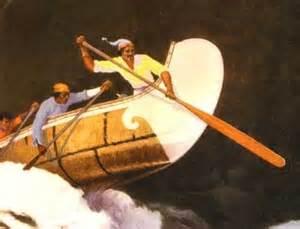
You ride the waves. Oh Voyageur!
Sun beating on your leathered back,
As muscles strain 'gainst breaking waves
In deep uncharted wilderness.
While as you toil, there comes a tune,
When dipping paddles to the song.
A shanty sung as you traverse
Vast waters of this wild bold land.
Between the lakes you portage packs,
Along a twisting rooted trail,
Past cascade falls that would deny
Swift passage any other way.
These grizzled veterans of the North
Delighted in their labor's fruits.
| Author Notes |
For the contest a Portrait of the Voyageur.
Iambic tetrameter Picture from Yahoo Images. |
![]()
By Treischel

Pickett's Charge at Gettysburg
(An Octogram)
Forced march, until the cry was heard,
The Rebel yell.
Piercing howl, July one to third,
It came from Hell!
Up to top Cemetery Hill
Pickett charged to break our will,
Awful sound, that broke the spell,
The Rebel yell.
Minnesota's First, bayonets,
Charged out as well.
Bravely risked lives, without regrets,
As many fell.
This heroic move helped to save,
Some reinforcement Generals crave,
To silence Southern sound, dispel,
The Rebel yell.
| Author Notes |
The battle of Gettysburg raged for 3 days, July 1 - 3, 1863. Considered to be the turning point of the American Civil War. Pickett's Charge occurred on July 2 to take the heights at Cemetery Hill. The Minnesota 1st, Infantry Regiment held off the rebel charge with a suicidal counter attack with fixed bayonets against the entire Confederate Brigade, and a much smaller Regiment force, that day. This allowed Meade to position reinforcements, that saved the day. There is a statue on the battlefield commemorating the heroics of the Minnesota 1st.
This poem is an Octogram. .The Octogram is a style of poetry invented by Fanstorian Sally Yocom (S.Yocom). It consists of two stanzas of eight lines each, with a very specific syllable count and rhyme scheme. Syllable count is 84848884, repeat on second stanza. Rhyme scheme: aBabccbB ababddbB, where B repeats same text. No more than 16 lines. The tempo is tetrameter on the 8 count line, and dimeter on the 4 count line, but not iambic. The artwork is from Yahoo Images |
![]()
By Treischel
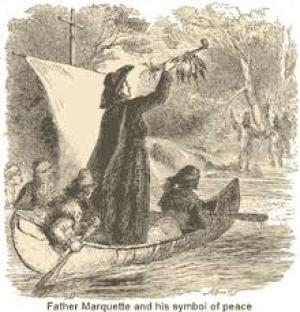
1. Pre-European
Land known for its lakes, but river defined,
The wilderness broached by paddles and oars,
As new land is now revealed to mankind,
Broad waterways opened up unexplored shores.
From the beginning, 'twas land that was blessed
With forests where many animals roam
And fish-filled waters for anglers to test.
A place indigenous peoples called home.
The Black Duck, makers of effigy mounds,
Have lived and prospered for nine thousand years.
Their sacred lands and tribal hunting grounds
Contain their ancient arrowheads and spears.
Then came Ojibwa, Cherokee, and Sioux,
To gather the moose, hare, beaver and bear,
The turtles, wolves, and the buffalo too.
All there for taking as food, use, or care.
These various cultures waged wars, yet thrived
Before the Europeans first arrived
2. Great Lakes Exploration
Before the Europeans first arrived
The natives lived by custom, wits and chance.
The legends of contact rumors survived -
Maybe the Vikings, but certainly France.
The French were already in Canada,
The St. Lawrence River, had founded Quebec,
And had brave explorers with stamina,
To go on any adventurous trek.
Among the first, Etienne Brule,
Who followed the St. Lawrence River trace.
He sailed the Great Lakes, where Indians say
The sacred Great Spirit founded their race.
Then De LaSalle sailed along shoreline banks
With Hennepin, to seek a passage north.
They built a boat out of wooden planks.
The "Griffon" named, it quickly sallied forth.
They soon encountered huge Niagara Falls.
So noted, in Hennepin's diary scrawls.
3. Northern Mississippi River Discovery
So noted, in Hennepin's diary scrawls.
Just one of many appear in his book.
LaSalle sent him on, while he built fort walls,
In hopes to give Mississippi a look.
With two companions in birch-bark canoe,
The three set off into the vast unknown
Down Illinois River. They found it too!
That mighty river had finally shown.
He claims he sailed to Gulf of Mexico,
Then all the way back to Minnesota.
Historians argue, "Where did he go?"
He was detained for years by Dakota.
The Sioux kept him captive, traveled with them.
He saw it, and named St. Anthony falls.
Today it's a Minneapolis gem.
Back then, an item his memoir recalls.
The most famous facts historians draw --
Two North American falls that he saw.
4. Duluth Makes Way for Fur Traders
Two North American falls that he saw
Became his most notable legacy.
Remember, he's under his captive's paw
And needed release from captivity?
Well, that fact's this tale's most notable truth.
Then from the garrison at Montreal
Comes Daniel Graysolon, Sieur Du Lhut
To negotiate Hennepin's recall.
He was an intrepid interpreter,
Negotiated many Indian truce,
Superior's new fortress outfitter,
His treaties set northern fur traders loose.
They settled the region, married within
The chief's blessings, the women of the tribes.
A brand new culture, the Meti, begin
To live among them, as record describes.
And so we find cultural unity,
A French and Indian community.
5. The French Claim
A French and Indian community
That lasted until other nations came.
'Twas culture blended with impunity,
Without a bit self-consciousness or shame.
The upper river was mapped by Marquette,
La Salle, for France, declared a large land claim,
The whole Mississippi basin was set
To become a part of French King's domain.
"New France" was what this area was called,
But map creators named it for the King,
So Louis XIV's name was installed.
"Louisiana" had a better ring.
Now, while all this claiming was going on,
The priest explorers mapped, wrote, taught and held
Their services, in spots they came upon.
Their knowledge of peoples and regions swelled.
The priests were transcribing America
Within its vast uncharted area.
6. The Voyageurs
Within its vast uncharted area
Was land Minnesota finally became.
Where waterways with the criteria
Have beavers that brought voyageur acclaim.
Through woods, streams, and lakes, they'd paddle all day
And portaged with large canoes on their backs
In the pristine BWCA.
Their legends live in historical tracts.
The Sixteen Hundreds were the eras when
The Frenchman thrived in forests and on lakes.
There weren't many towns or forts back then.
They lived on the wild paths that nature takes.
Respecting people and environment,
The fur-traders and the bold voyageurs,
Who opened ways for future settlement
Followed the lead of those first explorers.
That type of person was never content
To live anywhere but teepee or tent.
7. Legacy
To live anywhere but teepee or tent,
Where wind rules the waves in the bays,
They traveled the rivers, the lakes, these men
Who left their marks where their influence stays.
Along with others who much later came
To search Minnesota's interior
A Wisconsin river bears Brule's name.
Its rapids flow into Superior.
You'll see Hennepin in many a place
Nearby St. Anthony's falls, that he named,
And Father Marquette's names frequently grace
Those charts in parts that his trip maps proclaimed.
And Daniel Greysolon, don't forsooth
His role exploring the unknown Great Lakes.
His name recalled in the Port Town, Duluth,
A fit reward for his journey's high stakes.
All brave men who traveled water to find
Land known for its lakes, but river defined.
Minnesota.
| Author Notes |
This poem is about the early explorers of the region that later became Minnesota.
1620's Etienne Brule (born in France) Fur Trader/Explorer; Brule is credited as being the first European travel past the St Lawrence River and to reach Lake Superior in 1622-23. Some historians believe that he may have reached the end of the lake, (present day Duluth). 1670's Louis Joliet (born in Quebec City, Canada) and Father Jacques Marquette (born in France) In 1673 Joliet (Fur Trader) and Father Jacques Marquette (French Jesuit missionary) were the first to reach and map the northern portion of the Mississippi River. They traveled about halfway down the Mississippi to about Arkansas, but turned back to avoid capture by the Spanish who were in the southern part of this territory. Daniel Greysolon, Sieur du Lhut In 1678, reached the interior of Minnesota, but returned to Lake Superior, then traveled up the northwest shore to build a post on the Kaministiquia River, near Thunder Bay. In 1679 he met with Dakota Indians near Lake Mille Lacs, and returned in 1682 to negotiate the release of Father Hennepin from captivity. Father Louis Hennepin (born in the Netherlands) In 1679, Hennepin sailed with Robert de LaSalle from Canada through the Great Lakes aboard Le Griffon to explore the unknown West. In 1680 they reached the mouth of the Illinois River. La Salle sent Father Hennepin northward on the Mississippi to explore the area now known as Minnesota. Hennepin is the first to discover St. Anthony Falls. He was captured by a band of Dakota Sioux. He was held captive for a couple of years and traveled with this nomadic people as they moved about the region. After his release, he journeyed with Geysolon back to Montreal. Then he returned to France, where he published several books about his journeys. Some historians believe he exagerated many facts. Robert de LaSalle (Rene-Robert Cavelier, Sieur de La Salle, born in Rouen, France) French explorer; In 1682, La Salle claimed the entire Mississippi River basin for France, a huge area that included modern day Minnesota. Source: Minnesota Fun Facts and Trivia. Details: The Kensington Runestone - an artifact found in Minnesota that is believed by many to be of Viking origin. Historians have challenged its authenticity. The Erie Canal was later built to connect the St. Lawrence River to Lake Erie. St. Lawrence river was portaged (walked) in the early days to gain access to the Great Lakes. When De LaSalle made his exploration, they walked the portage, then felled trees and built the boat that he christened "The Griffon". A Griffon is a mythical beast, part lion and part eagle, that was part of his family's coat-of-arms. BWCA - Boundary Waters Canoe Area, is a vast region in northern Minnesota and Canada that contains hundreds of lakes with short and long portages between them, so that by using them, hundreds of miles can be traversed. By traveling by river, lake and stream a person can actually go from Hudson's Bay in Canada, all the way to the Gulf of Mexico, in a canoe. Meti - the children of Indian and French people resulting from mixed marriages. This poem is a Crown of Heroic Sonnets: A Crown of Heroic Sonnets is a sequence of seven sonnets, usually addressed to some one person, and concerned with a single theme. However, instead of having the usual 12 lines with closing couples for a total of 14 lines, a Heroic Sonnet has either two octaves with closing couplets or 4 quatrains with closing couplets for a total of 18 lines. Each of the Sonnets explores one aspect of the theme, and is linked to the preceding and succeeding Sonnets by repeating the final line of the preceding Sonnet as the first line of the succeeding Sonnet. The first line of the first Sonnet is repeated as the final line of the last and final Sonnet, thereby bringing the sequence to a circular close. Written in iambic pentameter, no rhyme is to be repeated, except those of the repeated lines. The rhyme scheme is to be either: abababab--cdcdcdcd--ee (using octaves), or: abab--cdcd--efef--ghgh--ii (using quatrains). Some feminine and Anapestic meter unavoidably crept into a few lines. However, I feel the flow remained in tact. The majority of the lines remain iambic pentameter. This picture is from Yahoo images. |
![]()
By Treischel
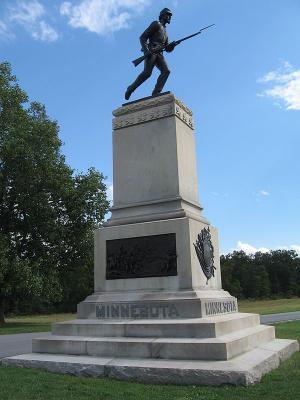
I shall recall famous stories, of soldiers from our state
Who fiercely fought the Civil War, and bravely met the fates.
1. The War Begins (April 13, 1861)
April Eighteen Sixty One arrives, artillery in action.
There's news of Civil War caused panic, coming from the South.
Something bad is brewing at Sumter, shelling at the fort.
Alexander Ramsey's army, is activated first
While waiting there in Washington, walking in local park,
The Governor grants Lincoln, use of Minnesota's Guards.
As the "call to arms" is announced, an Army marches forth.
One thousand nine volunteer troopers, soon take the war oath.
The Senate sets a 3 year stint, signed up and marched away.
Just sixteen days since Sumter, our young soldiers march to war.
From Fort Snelling fighting field they march, many are on foot,
Our State selected soldiers, sent to Alexandria.
When volunteers get to Virginia, vying gallant fight,
They're marched and maneuvered many days, as the months go by.
2. The First Bull Run at Manassas (July 21, 1861)
In Manassas battle called Bull Run, many boys soon died.
North callously confident, when citizens watched nearby.
Southerners succeeded, victory for seceded states.
The Run became a Union route, when lines broke they just ran.
But the battery in the middle, held the battle line.
Rickett's cannon was reinforced, retreat was thus contained,
On Henry House Hill charging stopped, Minnesotans held firm.
Firing guns fiercely in their midst, Rebel foe was repelled
Until Union cause was useless, withdrawn under duress.
Covering campaign's retreat, created certain havoc.
Minnesota men where last, to move from bloody battle.
With a field that's full of bodies, and frenzied citizens,
The Republic was in panic, with the patrons fleeing town.
Had Lee not failed to follow up, war would soon be finished.
The fear and fate set loose that day, saved the fickled Union.
Still, our fellows at First Bull Run, were the fiercest unit,
With final casualties counted, calamity declared.
With twenty percent lives lost, losses exceed all others.
The highest human loss, from a hard learned engagement.
3. The Battle of Antietam at Sharpsburg (Sept 16-17, 1862)
September soon saw Sharpsburg, as the South invades the North
Antietam is another name, for action near this place.
McClellan made the most mistakes, missed his opportunity
To win with overwhelming odds, an outright victory
In far flung fields, Antietam creek, and forested high hills,
When the Union's plans waivered, the war became disjointed
As conflict in the center cornfield, changed hands 15 times.
Antietam's annals all record, the action in West Woods.
Stonewall Jackson enjoined the fight, just before hilltop line.
Sedgewood's union foray failed, but 1st Infantry still stood
To hold back rebel harassment, and break their horrid will.
The fiercest fire saved a route, as bullets filled the air.
Three times their torrid shots unleashed, they took Grey's colors down,
A hail of hellfire ruled the day, then bayonets in hand.
The boys where blooded in those woods, as battles often would,
While 28 percent were lost, South's leverage was wasted.
But blunders by the Northern brass, made battle inconclusive.
Still Lee became the first to leave, left to fight another day.
Enough encouragement to cause, epic's victory claim.
Lincoln's plans produced, Emancipation Proclamation.
4. Gettysburg (July 1-3, 1863)
It's here the Minnesotans made, most memorable mark
Where President's performance, proclaimed this place hallowed ground,
Where armies met and aired their wrath, against angry armed men.
Where Pennsylvanian pastures played, pivotal wartime role.
Here great actions at Gettysburg, had armies grand and strong
Engage their enemies three days each, an extraordinary time.
From first to third the fighting raged, the fiercest of the War.
The conflict centers on a hill, named Cemetery Ridge.
Union cannon clear below, as collected rebels charge.
Enjoined in battle July 2, jagged line in peril,
Minnesota men rushed in, to mend broken battle line,
When Colonel Colville ordered it, they charged right in headlong.
Two hundred sixty two were sent, these true heroic men,
Outnumbered only five to one, they overtook the rebs.
This unit's flag fell five times then, but flew again each time.
The battle raged relentlessly, 'til reinforcements came.
Which Winfield Scott Hancock had hoped, would hold the cannon's ground.
Had rebels reached the top, repercussions would be dire.
1st Infantry's fine sacrifice, would find it all for naught.
Two hundred fifteen men died fast, in those fatal minutes
It took to buy the time, to reinforce terraced summit.
Eighty two percent lives ended, expelling rebel charge.
Death rate ran so rare, it remains the highest to this day.
But the bitterness was yet to come, by the next day's date.
Since July 3rd was to see, another serious threat.
When Pickett called his famous "Charge", we countered once again.
Minnesota's troops fought the Middle, mayhem all around,
Repelling Rebel's rushed advance, avoiding another route.
Five hundred heroes charged that day, but how many survived?
Only eighty eight left alive, everyone a story.
In the heat of heavy combat, unheard of valor reigned,
While many dead and wounded, would sacrifice their lives.
Heroic Henry O'Brien wounded twice, held the Union flag,
Battered and bleeding he held it high, helping battle pride.
Then Private Sherman picked the rebel flag, putting to shame
28th Virginia's vain colors, vented and retained.
Trophy of that torrid fight, tightly held within our state.
And through it all the troops prevailed, and turned the rebel's tails.
So twice they held the Southern charges, and twice they saved the day.
Early's ended July 2, Pickett's ended July 3.
The Unit's legend lives today, this battle leads the way.
Their glory gained in battle, kept our grateful nation saved.
Minnesota's moments praised, monuments on battlefield.
Their courage is recounted, in colorful citation,
Right there on Cemetery Ridge, the record stands in stone.
A Regiment renowned, remains upon its hallowed ground.
5. Other Actions
The company campaigned Fredericksburg, but not contending,
Rearguard reinforcements, recognition of their losses.
At Chancellorsville carried the dead, no casualties were had.
Fought in Bristoe battles, and behind battle at Mine Run.
But no more casualties were borne, beyond those said before.
Even politics played part, when President Lincoln asked
To quell the querulous draft riots, quiet New York Streets,
They garrisoned at Governor's Island, gave the city peace.
After epic enlistments ended, exercised their right,
To muster out as honored men, marched back to the fort.
Treated as triumphant heroes, in towns along the way,
A Thousand nine troops marched to war, but 309 remained.
6. Epilogue
You'd think that ordeal would do it, their duty had been done.
Most reenlisted when new units went, 'til war was won.
| Author Notes |
This is the story of just one Minnesota military unit that fought for the Union in the Civil War. The 1st. Minnesota Volunteer Infanrty is the most famous. In fact, Minnesota sent 11 Infantry Units, 4 Calvary units, and 4 Artillery units to the Civil War. I'm focusing on the most distinguished one.
All the Minnesota units were unique when it came to enlistments. They all signed up for 3 full years, when the prevailing Civil War enlistments were initially for 3 months. That short enlistment period caused the President and Generals a great deal of problems at the beginning of the war, reflecting Northern overconfidence in its duration. It is also why the Minnesotans saw so much continuous action. By happenstance, Minnesota's Governor, Alexander Ramsey, was in Washington D,C, when Fort Sumter was attacked. He immediately offered the Minnesota Guard to Lincoln. As a result, Minnesota was the first state to provide troops to the war. Cronology of Events and Battles that Minnesota 1st, involved in: Fort Sumter attacked........................................................ April 13, 1861 Troops leave Fort Snelling, Minnesota.............................. April 29, 1861 Bull Run................................................................................July 21, 1861 Ball's Bluff...............................................................................Oct 21, 1861 Pennsylvania Campaign.......................................May through June, 1862 Richmond, 7 Days Battle .......................................June 25 to July 1, 1862 Antietam.......................................................................Sept 16 & 17, 1862 Fredricksburg...............................................................Dec 11 to 15, 1862 Chancellorsville.....................................................April 30 to May 6, 1863 Gettysburg..........................................................................July 1 to 3, 1863 NYC Draft Riots(when not Battling)...................................July to Dec, 1863 Battle of Bristoe........................................................................Oct 14, 1863 Mine Run...................................................................Nov 27 to Dec 2, 1863 Headed home ...............................................................................Feb, 1864 Mustered out...........................................................................April 28, 1864 The First Battle of Bull Run was a wake-up call to the North. Many expected the war to end in one battle. Citizens with their families came in their carriages and set up picnic blankets to sit and watch the battle. Nobody expected it to be as fierce and brutal as it turned out. The South routed the Union troops. The roads back to DC were jamed with fleeing citizens and soldiers, but the congestion and confusion of an overturned military supply wagon, heavily protected, caused the pursuing Confederates to withdraw. But for that, the road was open to Washington D.C. Had Lee followed up his victory, the Capital would have fallen. As it was, there was panic everywhere and many fled the city. Nevertheless, Minnesota's unit was noted as a fierce fighting unit that covered the "retreat" and delayed the South's advance. The battle at Antietam was an inconclusive draw, but the war had been going badly for the North up to that point, and since Lee withdrew from the field first, it was enough for the North to claim a victory. Lincoln used the victory as the proper time to release the Emancipation Proclamaition. Those two events bouyed the fighting spirit of the North. The monument to the Minnesota's 1st. Infantry is used here as the poem's image. Two members of the unit received the Congressional Metal of Honor. Private Marshall Sherman survived the fighting and managed to capture the Battle Flag of the 28th Virginia Regiment while under heavy fire and being wounded. Corporal Henry O'Brien survived to battle on July 2, helping several wounded comrades to safety while under heavy fire. Then on July 3, while bandaged from the previous fight, carried the Union battle flag. He was wounded in the head and knocked unconscious but never dropped the flag. Revived, he raised the flag and rallied the troops, getting wounded in the hand. Carrying the flag in his other hand, and bleeding, he helped lead the counterattack that turned the tide. The Confederate Battle Flag that was captured is still in Minnesota's Historical society. It was the object of a lawsuit with the State of Virginia in the late 1990's. They wanted their flag back, but lost their case. In 1863, President Lincoln instituted the first military draft. The announcement caused widespread riots throughout New York and Baltimore. The Minnesota 1st Infantry was sent to New York City to quell them there. They instituted marshall law and imposed a curfew. They were stationed at Governor's Island from July to December, but they were interupted twice and left to fight a couple battles, then return to keep the peace. The stone monument at Gettysburg is located on Missionary Ridge. The soldiers who died there are buried in its National Cemetery. There is a plaque on the monument that reads, "On the afternoon of July 2, 1863 Sickles' Third Corps, having advanced from this line to the Emmitsburg Road, eight companies of the First Minnesota Regiment, numbering 262 men were sent to this place to support a battery upon Sickles repulse. As his men were passing here in confused retreat, two Confederate brigades in pursuit were crossing the swale. To gain time to bring up the reserves & save this position, Gen Hancock in person ordered the eight companies to charge the rapidly advancing enemy. The order was instantly repeated by Col Wm Colvill. And the charge as instantly made down the slope at full speed through the concentrated fire of the two brigades breaking with the bayonet the enemy's front line as it was crossing the small brook in the low ground there the remnant of the eight companies, nearly surrounded by the enemy held its entire force at bay for a considerable time & till it retired on the approach of the reserve the charge successfully accomplished its object. It saved this position & probably the battlefield. The loss of the eight companies in the charge was 215 killed & wounded. More than 82% percent. ....In self sacrificing desperate valor this charge has no parallel in any war. " The Conferderate officer, Sickle, was under the command of General Jubal Early. This photograph is courtesy of the Minnesota Historical Society. |
![]()
By Treischel
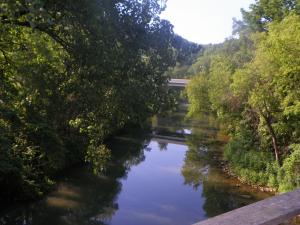
Put me in a sleek canoe,
On a river, in the wild.
Even for a day or two,
Gets me happy as a child.
Any true adventurer
Wants the river and the trees,
Habitat of Voyageurs
With a paddle 'cross their knees.
You can't find a better place,
With hardwood in your hand,
Feeling Nature's charm and grace,
As you flow across the land.
Silence of the wilderness
Will put all your cares away,
When water and trees caress
The shore, where eagles play.
There may be some romantics
Who will bring along their dogs,
And smile at all their antics
Sniffing at the likes of frogs.
Mallard ducks may follow you
While drifting by in peace.
You may spot a deer or two,
Or pass by a flock of geese.
Muskrats and the beaver too
Frolic in this wild domain
That you slowly paddle through
Without any stress or strain.
Then hear the rippling water
As it tumbles over stones
Wherever rapids wander.
You'll feel it in your bones.
Around the bend each vista
Brings new enticing views
That sets canoe charisma
As the highlight of the cruise.
A weathered piece of driftwood
May float by just out of reach
About the time it's understood
Lunch is neat to eat on beach.
Gentle breezes cuddle you,
Under the warm summer sky,
Its canopy -- a brilliant blue,
Just to please a poet's eye.
Later the final landing
Is found lurking 'round the bend.
The trip was so outstanding
That you don't want it to end.
Sadly sigh as you begin
Pulling boat up shore-side ramp,
There remains a boyish grin
As you start tasks making camp.
Placed so near to lovely loons
In their regal bird attire.
Singing out their lonely tunes
As you light the evening fire.
So, sit around the campfire.
Talk of day's particulars.
Then, when the embers expire,
Fall asleep beneath the stars.
| Author Notes |
I love to canoe, as well as camp. This poem reflects some of the reasons that this activity appeals to me. As a Minnesotan, the water has drawn me ever since I was a boy. The canoe is my favorite, although I have kayaked and rafted too. It cruises effortlessly down stream on a good river current, and is silent enough to not disturb wildlife. Lake paddling is equally rewarding, albeit a bit more demanding in windy conditions and with required portages. But the great outdoors beacons me. My spirit responds to water. I feel blessed to live in the "Land of 10,000 Lakes", and rivers too. This picture is one I look of the Root river near Lanesboro, in southeastern Minnesota. It is an area of rolling hills, about a two and a half hour drive south of the Twin Cities.
This poem is simply a series of abab rhymed Quatrains. I did choose to write it in an unusual meter that carries only 7 syllables per line. This photograph was taken by the author himself on June 30, 2012. |
![]()
By Treischel
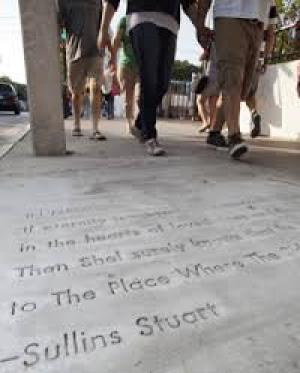
What makes a neighborhood good
are the people walking these trails,
who find the way where others fail,
and "Love Thy Neighbor" is understood.
| Author Notes |
The city of St. Paul is looking for poets for the 8th Annual Sidewalk Poetry contest. The city partners with Public Art Saint Paul to host the contest. They are looking for strong, short, concise, honest, well-written poems, that are to be concise, to the point, but not be boring. The poems can be about anything, but the they can't exceed 250 characters or 10 lines, and the author must live in St. Paul.
So here is one of my two allowable entries. The other is a poem I posted here earlier entitled "Sidewalk Adorned". |
![]()
By Treischel
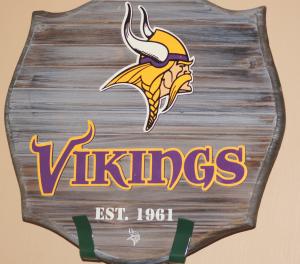
Sports, often dominated
by perennial
team powerhouses,
shine celestial.
Odd makers love them,
but others still strive.
Nobody gave the purple a chance.
Still, they stayed alive.
Yes, it wasn't all pretty,
as some losses sucked.
Vikings fought back!
Some vict'rys were plucked
from the depths of despair.
When season begins,
nobody gave the purple a chance.
Wow! Eleven wins!
Exactly the opposite,
from what they all say.
Deigned the bottom,
the Vikes beat Green Bay.
Captured the moment!
Since first training camp,
nobody gave the purple a chance.
Now, division champ!
| Author Notes |
On Sunday night January 3, 2016, my team, a professional American football team, the Minnesota Vikings, defeated the Green Bay Packers to win the NFC Division Championship, and put them into the playoffs. The team color is purple, so they are often called "The Purple". There are 16 games in a season that starts in July with Training Camps. There are four teams in the division - the Green Bay Packers, the Minnesota Vikings, the Chicago Bears, and Detroit Lions. The Packers are the perennial winners of this division, and have won it the last four consecutive years. Since the beginning of training camp, the Vikings were expected to be at the bottom of the division. With Sunday's win, they finished with a record 11-5 to win the title and home field advantage in the first playoff game. So this poem is to celebrate that victory. Here's to success in the playoffs and a Superbowl Win!
This poem is a Lyricat. The Lyricat is a newly invented verse format by I am Cat, a fellow FanStorian. It carries facets of a free verse as well as a rhymed poem. There are several short lines with a couple of longer lines embedded, to give a fast and catchy spirit. The long repeated line interlinks the stanzas for a powerful impact. The LyriCat has a syllable count of: 7, 5, 5 , 5, 5, 5, 9, 5, and the rhyme scheme of each individual stanza is: a, b, c, b, d, e, F, e. No set rhythm is prescribed. It has a 3 stanza minimum and the 9 syllable line (F) in each stanza is a repeating line. This photograph was taken by the author himself on January 5, 2016, of one of several team memorabilia items he owns related to the team. |
![]()
By Treischel
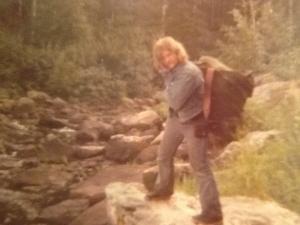
The northern woods have had a pull on me.
It seems that's where I often want to be.
The wilderness, like sing-song of the loon,
will call to me with sheer intensity.
For who could listen to that eerie tune
and not be touched, at all, by mystic moon?
I long to go where Voyageurs have tread.
Through woods on waters, I must too commune.
As vistas painted wild before me spread,
like masterpieces of the watershed.
I'll find my way along an unknown track,
to places only compass points have led.
I carry my provisions on my back,
in Number 4 Duluth Provision Pack.
With portages imperative to do,
the exercise on trails provide no slack.
But mostly, I'll be in a sleek canoe,
admiring all the lakes to paddle through,
and tossing fishing lures in glacial pools,
to catch a tasty dinner fish, or two.
The Ways of Wilderness aren't taught in schools.
You learn them in the woods, where Nature rules,
and when you do, it sets your spirit free
to travel where there'll be no city fools.
| Author Notes |
I am sorry for the poor quality of the photo, but I had to take a picture of a picture. This is me in the woods, in my early twenties. A friend of mine and I would go up to the Boundary Waters Canoe Area (BWCA) in the summers on a two week trip. We'd portage into as many as twenty lakes. We could probably be guides up there. Back then you might see nobody at all for those two weeks. We had to read maps and compasses, and lift our food high into the trees at night, in order to prevent bears, wolves, or raccoons from getting to it. In the picture, I'm putting on a NO. 4 Duluth Pack. On a portage, one of us would carry both a 100 pound pack in back, and another in front. The other of us would take a pack on the back, and the canoe, paddles, and fishing gear.
This poem is an Interlinked Rubiat. It takes on all the attributes of a Rubiyat written in iambic pentameter. In this Persian form of poetry is a series of rhymed quatrains. In each quatrain, all lines rhyme except the third, leading to this pattern: aaba. An "Interlocking Rubiyat" is a Rubiyat that utilizes that unused rhyme of the quatrain to interlink with the next stanza. Whereby the subsequent stanza rhymes its 1st, 2nd, and 4th lines with the sound at the end of the 3rd line in the stanza before it. In this form, the 3rd line of the final stanza is also rhymed with the 3 rhymed lines in the first stanza. This leads to a form like this example with three stanzas; note that the Rubiyat is allowed an unlimited number of stanzas, so extend the pattern as needed: aaba bbcb ccdc ddad ..... This photograph was taken on trhe author's camera by his friend Chris Jensen, sometime around 1967. |
![]()
By Treischel

"To love thy neighbor, as thyself,"
says book on shelf.
We must act out
and spread about.
Guiding principle that's timeless,
without bias,
professed with care,
so we might share.
A visible curbside treasure,
beyond measure,
moral jewel --
The Golden Rule.
| Author Notes |
I saw this along a street in downtown St. Paul, Minnesota. Well, the muse struck me and I took the photo.
This poem is a Minute Poem. The Minute Poem is a poem that follows the "8,4,4,4" syllable count structure. It usually has 3 stanzas that are exactly the same. So: 8,4,4,4; 8,4,4,4; 8,4,4,4 syllables. A traditional Minute Poem has 12 lines total. It has 60 syllables (thus the minute). It is written in a strict iambic meter. The rhyme scheme is as follows: aabb, ccdd, eeff. In this one, I intentionally did not follow the iambic meter requirement. I hope you like it anyway. This photograph was taken by the author himself on May 14, 2016. |
![]()
By Treischel

Our stadium debuts today.
Today the fans will get to see,
and watch our team put on display,
display of border rivalry.
A rivalry on new home field.
Field bracketed in sculpted glass.
Its architecture, now revealed,
revealed for dreams to come to pass.
To pass, best way to start first game.
Game played within this stadium
against the Packers, whose acclaim,
acclaims great equilibrium.
An equilibrium to team,
team set to face its stiffest test.
Our fans hold fast to foremost dream.
Dream that our Vikings are the best.
Best wishes raised to crystal peak!
Peak pointed to a new decade,
where champions will rise and seek,
seek football's highest accolade.
| Author Notes |
For those Fanstorians who don't follow American Football, this poem is about the new $1.5 Billion Stadium, named the U. S. Bank Stadium, in downtown Minneapolis, Minnesota, that saw it's first NFL Football game played there on Sunday, September 18, 2016 between the Minnesota Vikings and the Greenbay Packers of Wisconsin. Those two teams have been rivals since the 1960's in this division. Wisconsin is easterly adjacent to Minnesota, so this game is known as a "border battle." Of course, Football's highest accolade is to win the "Superbowl." This picture is on that I took of it last week.
This poem is a Double Echo. The Double Echo poem was created by Sally Yocum. It is so named because both the first and third lines of each stanza have an echo in the following lines." So, in this style of poetry, the endings of lines one and three are repeated at the beginning of the next line. The ending of line four is repeated at the beginning of the next stanza. So the rhyme scheme not only has end rhyme, but also a word echo is its associated next line. It looks like this: Line 1: a1 Line 2: (A1) b1 Line 3: a2 Line 4 (A2)b2 Next Stanza Line 5: (B2) c1 Line 6: (C1) d1 Line 7: c2 Line 8: (C2) d2 and so on. Where the capital letters represent the echoed rhyme word. I showed two stanzas to show how the last rhyme carries over. No specific meter is specified. I wrote this in iambic tetrameter. This photograph was taken by the author himself on September 13, 2016. |
![]()
By Treischel
| Author Notes |
Three buildings that are unique are shown here in downtown Minneapolis: a theater, an office building, and a sports stadium. The foremost is the renowned Guthrie Theater. Behind, lurking like the prow of a ship, is the US Bank Stadium, home of the Minnesota Vikings, American football team. So here you have the arts, work, and sports intermingled. That is my thesis.
Tailgater - a common activity around a sports stadium is to tailgate, that is an outdoor picnic, or barbecue, in your parking spot before and/or after the game. Often quite a party in itself. Typically alcohol is involved. Atrium - referring to a Roman architectural feature, usually at the center of a building. Medium - a way of conveying something Theorem - pronounced in 2 syllables. Asylum - retreat, refuge This poem is a format I call Squeezed Octaves. Squeezes Octaves are my creation. Those who know me know, I often like a format containing 3 consecutive rhymes. So I created this one. It is structured with Octaves (8 line stanzas). It yields 2 short lines squeezed between 2 sets of 3 longer lines. It can have as many Octaves as desired, but a minimum of 2. The form reminds me of a sponge being squeezed. Thus the name - Squeezed Octaves. Each stanza has a syllable count of: 8-8-8-4-4-8-8-8 The rhyme scheme is: aaabbccc The meter can be variable or iambic as the poet desires. This photograph was taken by the author himself on February 20, 2016. |
![]()
By Treischel
The groaning gasp was real, watching my cities burn
as a once peaceful protest turned repulsive sight
of dancing carnage, bringing with it anxious fright
when blurred are social limits of what's wrong or right.
The protest vandals wreaking ruin without concern!
Above the deep'ning din are heard the plaintive cries
for help. Rapacious riot flames lick city skies.
No firemen! No police! And then, a precinct dies.
From whence do these intense emotions churn?
From violence, what lessons do we learn?
We were united 'bout a homicidal death,
universally condemned by one and all,
the nation's call for justice had been quickly met --
dismissal and charged police officers involved.
Two peaceful city's streets are viciously ransacked
destroying businesses completely innocent
while civil law protections become strangely absent.
When hundreds of stores get their doors and windows broke,
their inventories looted, shelves engulfed in smoke,
we find our sacred institutions now attacked
as many thousands riot, violently react.
Where were the mayors of Minneapolis and Saint Paul?
Why were there no responder responses to an urgent 911 call?
On the first night gangs of "protesters" roamed
for miles across the borders of both towns
in organized caravans, breaking panes,
looting local stores in all directions
Police were overwhelmed by numbers present there,
with orders to go "softly" by AG Ellison.
Protecting downtown had left no comparison
to burning areas the leaders jettison.
The message that was sent was that they didn't care.
So soon the mob took note of Precinct Number 5.
Protected well that first night, it will still survive,
but not the cars and stores when protest mobs arrive,
while pain, unrest remain unleashed upon the air.
What was Mayor's calculated thought?
What has abandoning the precinct taught?
Next day, he gave up the ground around Precinct 5
to angry crowds, about three thousand strong.
Then tried to cordon-off the nearby streets,
but when the mob attacked police disbursed.
Where were the cops as chaos chiefly reigned?
Or firemen as the store owners complain?
There's none in sight as limitless terror took control.
The truth was, anxious authorities abandoned
defenseless city streets to raucous rioters,
letting anarchy embolden blazing bedlam.
The fires freely burned. No help would come around.
The firemen who tried were badly beaten back.
It seems police in riot gear were on Prozac.
Their chief stood back, alarmed, afraid, and watched it all.
He was too timid to enforce or reinstall
the public's rightful peace, because so much mayhem
was perpetrated then by too many of them.
Where was the Governor when asked for help?
Should actions call for us to take his scalp?
Day three, I guess you'd say he tried to conjure up some force
by calling up just 500 local guardsmen,
but really such a token unarmed martial show
was not enough to hinder those huge unhinged crowds.
The mob just laughed into the guardsmen's shielded face,
threw insults, bottles, rocks, and even building bricks.
While tear gas deterred little of their terror tricks,
the crowd continued with anarchistic antics.
Then lines of soldiers disappeared without a trace.
The public left alone to best defend itself,
as helpless neighbors watched the looter's flames engulf
the very core of cities built on their behalf.
No single civil corps came forth to give them chase.
Where are any firemen? Where the cops?
The citizens are screaming, "I hope this stops!"
The President demanded that the leaders dominate
unruly groups destroying many neighborhoods,
Illegal rabble out depriving peaceful livelihoods.
The governor finally activated full guard units.
The fourth day dawned with massive marshal show of force
by then the hostile damages were mostly done.
The anarchists, Antifa, now already gone,
moved on to other target cities they could loot,
where under protest cover, chaos to impute.
And left behind, the peaceful protesters, of course,
to be arrested for beliefs they reinforce.
That was the time when all emotions churned.
Those were four days I watched my cities burned
| Author Notes |
I live in St. Paul, Minnesota, about 30 miles east from the spot where George Floyd was murdered by a Minneapolis police officer. Our city and its police force were not involved. Yet, 279 buildings in St. Paul were vandalized, looted, and some burned. Worse was done in Minneapolis. Yes, chaos came close to me. Two shopping centers nearby were attacked. At Sun Ray Shopping Center, just off McKnight Road, about 31 stores were damaged. Some just got windows broken. Some, like the jewelry store and Cub Foods were looted. Some had fires set. I live along McKnight Road. About 5 miles southeast of there, Valley Creek Shopping Center was also ransacked, where about half of the stores that I shop at were vandalized. The Wine Shop, Marshalls, and Target stores were broken into and looted. Thankfully the Lunds & Byerlys, where I buy my groceries, wasn't touched. It happened between 3 and 5 Pm, in broad daylight. My wife and I were innocently out walking in a park between those two shopping centers, unaware of the events unfolding all around. But when we went to get a DQ ice cream cone, it was closed down in fear of the riots that were going on at the Target store, one block away. The two gas stations near me, about 4 blocks from my house were vandalized and shut down for over a week. All this happened the first night.
Here's what I think. This was an organized and well planned event. It must have been set up weeks in advance, just waiting for the right spark to initiate their plan. The "peaceful protests" were instigated by the organized anarchists and criminals who used social media to gather large crowds with well-meaning and righteous indignation to their cause about police brutality and systemic racism. Those were the issues the planners used to hijack the gathering, using crowd manipulation techniques to turn them into an angry mob. The process was the same every day (and also used in other cities as well). First they peacefully marched them into exhaustion all day long, singing, chanting, visiting significant emotional sites, feeding their minds with slogans and speeches using bullhorns. Then, when night fell, they had a tired, frenzied crowd turned into a thoughtless mob. So the leaders would start a small fire letting the crowd revel in the flames, dance and sing around it. Fireworks would be set off to further create tension. It would escalate to a car. Finally, burning a building would start a full-scale riot. When cops were encountered at primary sites, the protesters would stand in line in front of police lines with arms raised shouting "hands up, don't shoot" while screened behind them the anarchists threw rocks, bottles, and bricks (all pre-staged) at them. While the cops were busy at certain locations (likely preplanned), organized caravans from out-of-town cars would fan out all over the two cities to destroy and loot. I watched a press conference on the third day with a Black Lives Matter leader. I expected her to decry the violence. Instead, she said that this was not a protest. It was an UPRISING. She noted that it was good that white people are finally feeling what black people feel every day. I believe that there are organized, well-funded people actively trying to ignite a race war within the United States. I believe there is another group, driven by our higher education system's socialist indoctrination that wants to tear down our capitalist society in order to replace it with a socialist society. I believe there is a third group, comprised of Democrats, and the Washington swamp people, that will go to any means to destroy our president, Donald Trump. All these groups have converged to this moment, and are cheered-on and aided by a biased and liberal press. My wife and I are afraid. I've never owned, nor wanted to own, a gun in my whole life. But I am contemplating that now. If I do, it will be a 9mm pistol, a shotgun, and an AR15. This poem is a Poetic Fusion. A Poetic Fusion is a poem consisting of three elements â?? Rhymed Stanzas, rhymed couplets asking a question, and a 4 line free verse comment following each couplet. |
![]()
By Treischel

When they ran across her, literally,
while grading the new highway 59,
in 1931 the working crew
had spread her ancient bones supine
aside, to continue down the valley
leaving her for the experts to pursue
the detailed origins of place and time.
Of her significance, they never knew
that those remains in agitated ground,
those archaic remnants, changed history.
This tiny female shifted the world's view
when scientific carbon dating found
a strange eight thousand year old mystery.
This new discovery was most profound.
She wore a necklace made of conch sea shells,
and carried dagger carved of antler bone.
At age sixteen she met some strange demise.
From boat? Through ice? It seems she drowned alone.
Though dry land now, it once had glacial swells.
The sediment that covered her lengthwise
had shells and silt depicting seabed zone.`
She never had a chance of bearing children.
She died in times before the Pharaohs ruled.
This Paleo-Indian, discovered
among the oldest found, was ridiculed
'til proven by scientific brethren -
Professor Albert Jenks who recovered
through tests, her historical acumen.
Four thousand years beyond what was believed,
the oldest bones found in America
once walked across the land-bridged Bering Sea
confounding lettered esoterica
to hunt the herds tribal pictographs leave
on cliffs and cave walls. Left for all to see
images in artistic replica.
Near Pelican Rapids there stands her monument.
It sits beside North Highway 59,
commemorating "Lady of the Lake."
Stone plaque atop a simple granite shrine,
with words that give a basic testament
to Minnesota Woman's last mistake
that left her bones a famous storyline.
| Author Notes |
This 8000 year old woman's bones were found in northwestern Minnesota in 1931
by a road crew that set the bones aside and continued on grading Highway 59 North, near Pelican Rapids. The roadside monument stands near where the bones were found. The remains were found the next day by a supervisor. Her bones were sent to the University of Minnesota, and evaluated by Dr. Albert Jenks. In 1976, her bones were given to the Sioux tribe, who reburied them in an undisclosed grave in South Dakota. She was among the oldest remains ever found in North America. For more on her story, here are a couple of links: https://ottertailcountymn.us/wp-content/uploads/2018/10/minnesota_woman_monument.jpg https://en.wikipedia.org/wiki/Minnesota_Woman This poem is a series of septets. It is done in 10 syllable mixed meter, with a rhyme scheme of: abcbacb. The image is a photo of the monument. |
![]()
By Treischel
When Cadwallader Washburn built a mill
right at the foot of St. Anthony Falls,
he left a legacy that would fulfill
a city, from which his pursuit installs.
As Minneapolis became "Mill City,"
with wheat becoming the new state's crop king,
its long, cold winters were a troubling pity.
for winter wheat to profit every spring.
So spring wheat was what all the farmers planted.
The problem was its tougher stubborn husks.
Cad Washburn had a plan the task demanded,
with rollers versus grindstones and wind gusts.
These rollers made of metal, corrugated,
would rip the husks to blow away the bran,
effectively to keep flour separated.
A process stone wheels couldn't countermand.
His flour moniker became "Gold Medal."
Its fame was later known as world renowned.
As farmers came along nearby to settle,
a city grew around the town he'd found.
About his General Mills, I hoped you'd learn
that Minneapolis owes much to Washburn.
| Author Notes |
My wife attended Washburn High School in Minneapolis, so I was curious about who this person, for whom that school was named, was. So I researched his name on the internet and found out that he was a very important person who founded the company that later became known as General Mills. But more than that, he revolutionized the milling process by creating one known as the Millings Purifier. Because of his mills. the prosperous city of Minneapolis grew up around it. This poem becomes part of my Minnesota History collection.
Cadwallader Washburn (April 22, 1818 - May 14, 1882) was an American businessman, politician, and soldier, was a member of the Washburn family of Maine. He was a U.S. Congressman and governor of Wisconsin, and served as a general in the Union Army during the American Civil War. In 1840 Minnesota became a territory after the way was cleared to open it by the purchase of the land from the Sioux. In 1856, the Minneapolis Mill Company was chartered by the Minnesota territorial legislature. Among the incorporators were Washburn's cousin Dorilus Morrison, and Robert Smith, an Illinois congressman who had acquired the rights to the water power at the west side of St. Anthony Falls in Minneapolis. The company struggled initially, and several of the early investors sold out. Washburn bought in and eventually became president. The company built a dam, a canal and a complex set of water transfer tunnels which were then leased, along with land that the company owned at the foot of the falls, to a variety of mills - cotton mills, woolen mills, sawmills and grist/flour mills, including one of their own. Soon after Minneapolis was born on the Mississippi's west bank, the city's flour milling industry skyrocketed. Powered by the mighty river and fed by boxcars of grain rolling in from the plains, the industry gave Minneapolis bragging rights as the "Flour Milling Capital of the World." But there was a problem. The first mills used traditional technology of millstones that would pulverize the grain and grind as much flour as possible in one pass.This system worked best for winter wheat. However, the harsh winter conditions of the upper Midwest did not lend themselves to the production of winter wheat, since the deep frosts and lack of snow cover killed the crop. Spring wheat, which could be sown in the spring and reaped in the summer, was a more dependable crop. However, conventional milling techniques did not produce a desirable product, since the harder husks of spring wheat kernels fractured between the grindstones. The gluten and starch in the flour could not be mixed completely, either, and the flour would turn rancid. Washburn solved this problem by inventing the Middlings Purifier, which made it possible to separate the husks from the flour earlier in the milling process. They also developed a gradual-reduction process, where grain was pulverized between a series of rollers made of porcelain, iron, or steel. This process resulted in "patent" flour, which commanded almost double the price of "bakers" or "clear" flour, which it replaced. He named his product "Gold Medal Flour," still available today. The Washburn mill attempted to monopolize these techniques, but Pillsbury and other companies lured employees away from Washburn and were able to duplicate the process. The city of Washburn in Bayfield County, Wisconsin was named after him as were Washburn County in northern Wisconsin and the city of Washburn, North Dakota, as well as Washburn High School in Minneapolis, Washburn Observatory, at the University of Wisconsin-Madison, were also named for him. La Crosse, Wisconsin, where Washburn is laid to rest at his memorial in the Oak Grove Cemetery, has a downtown neighborhood and park named for the former governor. Source Wikipedia. This poem is a Super Sonnet. A Super Sonnet is composed of several Quatrains closed by a Rhyming Couplet, as opposed to a typical Sonnet that has 3 Quatrains and a Couplet, this form contains 4 or more. If done with 4 Quatrains, it generally utilizes all four of the primary Rhyme Schemes: Alternate Rhyming - abab Coupled Rhyming - aabb Enveloping Rhyme - abba Skipping Rhyme - abcb However, I chose to have 5 abab Rhymed Quatrains here for a total of 22 lines, versus the typical 14 lines of a Sonnet. This picture is one I took of St. Anthony Falls, as it looks today. |
![]()
By Treischel
1. The Issue
Between two wars tough women won their vote.
They proved their value while the men were gone.
Traditions broke. The powerful took note.
Amazing, that it had to take so long!
Persistently, they sought their suffrage rights
between the Civil War and World War I.
For all those years they carried on their fights.
That's when the movement was begun and won.
They shined, when forced to overcome privation,
as men marched off to fight the bitter wars.
They filled the empty slots within our nation.
Took over manly duties, jobs, and chores.
All those strong women - mothers, daughters, wives,
filled factories, helped offices, ran farms.
Without their grit our country can't survive,
So menfolk, then, can take up martial arms.
Their perseverance kept the States afloat.
And through it all they proved that they should vote.
2. The Stirrings
And through it all they proved that they should vote-
a principle that should be obvious.
Yet early-on that privilege was remote,
In fact, denial was ubiquitous.
The Civil War that set the slaves all free
in 1865 did not reward
a woman's conduct of citizenry.
Her muffled voice was furthermore ignored.
In '68 amended Laws again
The Fourteenth gave the slaves their voting rights.
The Fifteenth defined "Citizens" as "Men,"
but Women's status gains were not in sight.
Igniting the wrath of Harriet Bishop
and Sarah Burger Strearns, great activists.
Those who proclaimed aloud "The jig is up!
A women's voting rights won't be dismissed!"
By '70, Suffrage nationally
was headed by Susan B. Anthony.
3. Minnesota Leadership
Was headed by Susan B. Anthony
while local women's groups in States were formed.
The Minnesota House in '70
saw Suffrage Bill, but legislature spurned.
In school board choices by '75
all women were allowed to cast their vote,
but still the Legislature yet deprived
the general right that women still promote.
In '81 the MWSA,
the Minnesota group that came to be,
had gained some minor statutory sway,
on Temperance and vote alacrity.
When 14 met in Hastings Minnesota
the nucleus of women's rights was wrought.
They marched and protested for each iota
of legislative female charter thought.
Then Martha Ripley's work in '85
made women's national event arrive.
4. Minneapolis AWSA Convention
Made women's national event arrive
in downtown Minneapolis that year,
where Henry Blackwell spoke to help revive
enthusiasm in the atmosphere.
14 State's auxiliaries attend.
Then Mayor Pillsbury spoke out about
how recent immigrant males ascend
above one half the population's clout.
While Lucy Stone focused on motherhood
and issues involving women and children,
the Governor of the Dakotas stood
to criticism for his suffrage tailspin.
The AWSA President Foulke spoke
on taxation without representation.
"Consent of all the governed," he'd evoke,
while Sarah Stearns pushed higher education.
Reported Martha Ripley, their petition,
A 16th Constitution proposition.
5. Continued Activism
A 16th Constitution proposition
was sent to Congress, where it quickly failed.
It continued in contested condition,
so yearly, Suffrage petitions prevailed.
The convention lifted the local chapter
to reach the movement's national scale,
and drew the note of local law adaptors.
The Populists, seek deletion of "male."
In Minnesota they nearly succeed
by Senate passing change in '93
when Julia Bullard Nelson had agreed
to work it with Ignatius Donnelly.
But the bill failed to pass within the House.
Not taken up before the session ended.
Any further offers where on the outs.
Through 1910's it was yearly contended.
In '14, enthusiasm was made
with Clara Ueland's city parade.
6. Revived Momentum
With Clara Ueland's city parade
the movement's lost momentum was regained,
when 2,000 bolsters all promenade
in Minneapolis streets unrestrained.
The era saw marches and hunger strikes,
suffrage songs, banners, also White House pickets.
State and Federal Suffrage attention hikes,
and even Congressional bedroom boycotts.
While constant pressure every year was brought
the legislation never passed at state
and constitution caucus went for naught
as national conventions arbitrate
The movement still continues on to grow
as women join the Suffrage enterprise
while legislative push persists to flow
and circumstance makes relevance to rise.
For women shined essential as before
because the whole world was engulfed in war.
7. WWI Requires Women Again
Because the whole world was engulfed in war,
resulting in a greater public need,
their patriotic spirit raised once more,
allowing wartime efforts to succeed.
The women's efforts were unprecedented,
in roles performed beyond their custom norm.
All social classes now were represented,
with some wearing credentialed uniforms.
From 1914 to 1918
the women learned skills and independence,
political punch priorly unseen,
to bring the movement's final ascendance.
In 1920 the Nineteenth Amendment
was finally ratified for women's rights
providing Constitutional supplement
signed after years of political fights.
It should be said that histories denote,
between two wars tough women won their vote.
| Author Notes |
I am putting together a collection of famous people and events in Minnesota for an eventual book. This is one of the events I want to highlight. I wanted to express what a huge struggle it was, as well as highlight some key people involved, with a focus on Minnesota's contribution. I don't think many historians mention the role that both the Civil War and WWI played in it, but focus mostly on the efforts in between. I highlight those war's impact here in this poem.
This poem is a Crown of Heroic Sonnets The Crown of Heroic Sonnets is a Sequence Poem consisting of seven Heroic Sonnets usually addressed to one person. It is concerned with a single Theme as each Sonnet explores a different Aspect of the Theme and is Interlinked to the preceding and succeeding Sonnets by repeating the Final Line of the preceding Sonnet as its First Line and by having its Final Line become the First Line of the next Sonnet. Also, the First Line of the First Sonnet is repeated as the Final Line of the Final Sonnet thereby bringing the Sequence to a close; a Circle uniting the Beginning and End of the entire poem. Thus, the name Crown. Each Sonnet uses a Heroic Sonnet Format to provide for a long story. I love the Form for historic presentations. A Heroic Sonnet is an iambic Pentameter based poem that adds a Heroic Couplet to either two Sicilian Octave Stanzas, or four Sicilian Quatrain Stanzas. In other words, it's eighteen lines of iambic Pentameter broken into three or five parts with the last part being a Couplet. The Rhyme Scheme has usually been; a,b,a,b,a,b,a,b - c,d,c,d,c,d,c,d - e,e (Octaves), or a,b,a,b - c,d,c,d - e,f,e,f - g,h,g,h - i,I (Quatrains). |
![]()
By Treischel
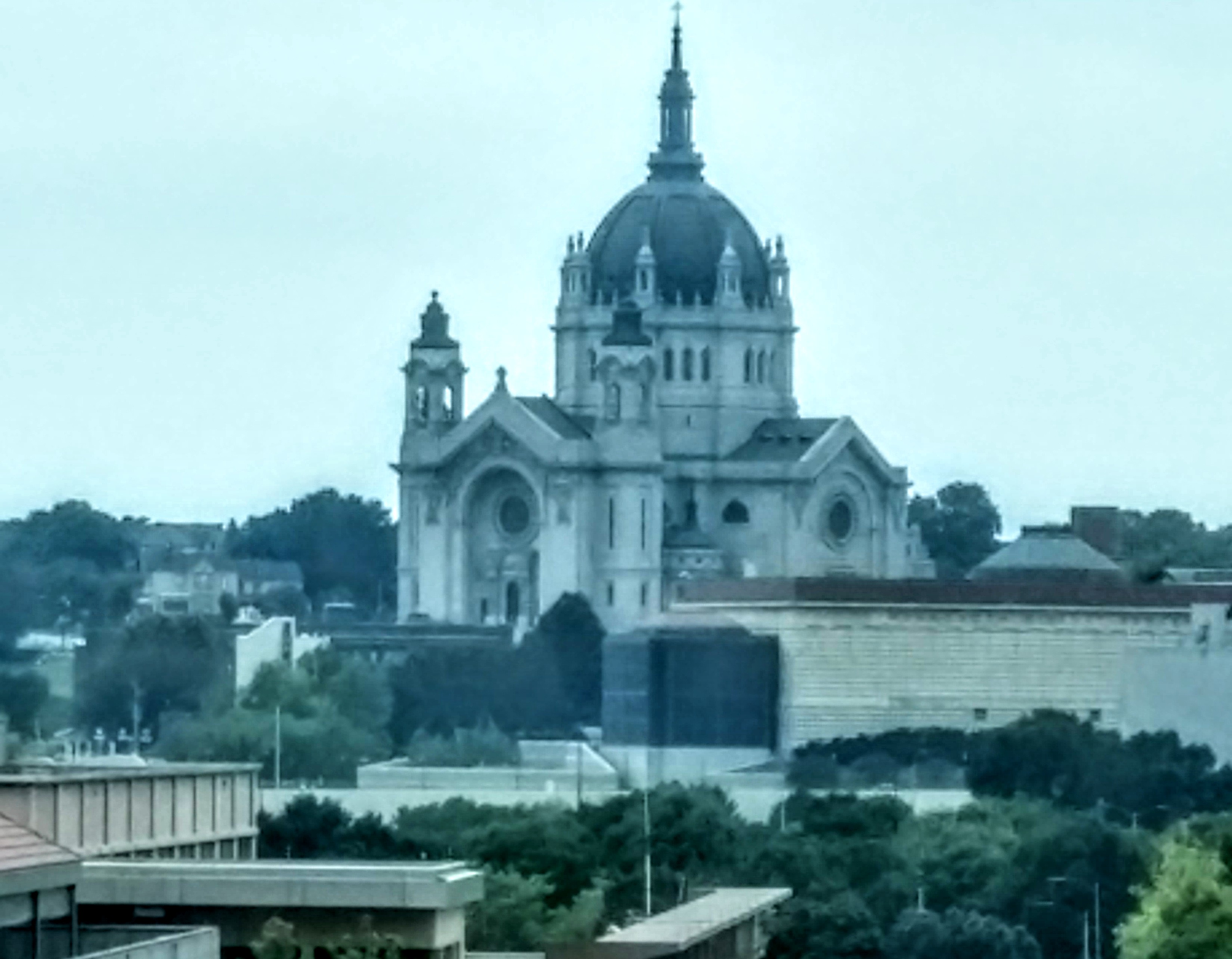
This church sits upon a hill.
It’s still highest in St. Paul,
which overlooks the city.
Integrity overall!
Center of the Holy See,
meant to be the Bishop’s chair,
presiding flamboyantly
to free us from all despair.
We are grateful that it’s there,
a prayer in marble stone,
reminder of our true goal –
to save our soul, sins atone.
We are grateful that it’s there!
| Author Notes |
This is the Cathedral of St. Paul in Minnesota. It does sit on the highest point in the city, overlooking the town.
This poem is an Awdl Gwydd. The Awdl Gwydd (pronounced like: owdle gow-widd) is a Welsh poetic format made up of quatrains with a specific rhyme scheme that repeat the end-rhyme of the first and third line as an inline rhyme in the second and fourth. It's important to state that Celtic poetry is based on sound structures to make them easy to remember, with rhyme not as important as repetition, alliteration and rhythm. Each stanza is a quatrain of seven syllables. Lines two and four rhyme rhyme with each other; lines one and three cross rhyme to form the inline rhyme into either the second, third, fourth, OR fifth syllable of lines two and four. So the rhyme scheme of each stanza becomes: a, (a,b), c, (c,b), where the lines in parens represent the inline-endline rhyme structure. For example, below I show two stanza layouts where the Xs are just syllables and the letters show the rhyme. The first stanza has the cross rhymes in the third syllable. The second stanza has them in the fifth. x x x x x x a x x a x x x b x x x x x x c x x c x x x b x x x x x x d x x x x d x e x x x x x x f x x x x f x e This image was taken by the author himself on August 29, 2018.. |
|
You've read it - now go back to FanStory.com to comment on each chapter and show your thanks to the author! |
![]()
| © Copyright 2015 Treischel All rights reserved. Treischel has granted FanStory.com, its affiliates and its syndicates non-exclusive rights to display this work. |
© 2015 FanStory.com, Inc. All Rights Reserved. Terms under which this service is provided to you. Privacy Statement